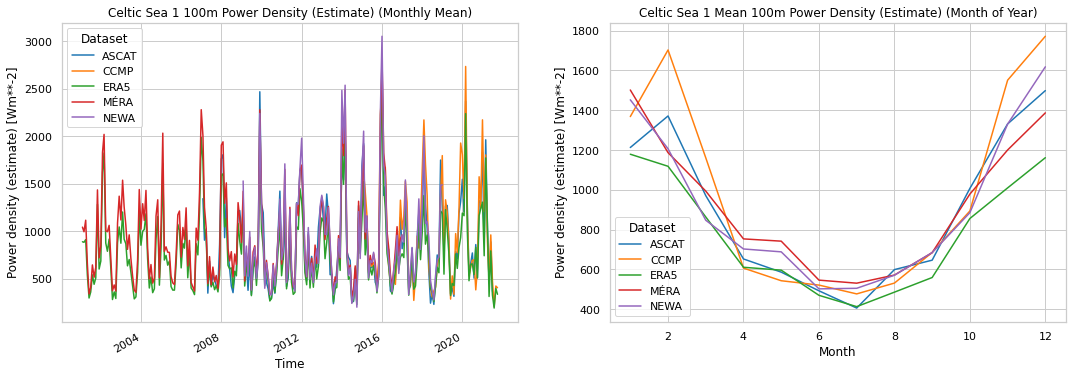Offshore Wind in Irish Areas Of Interest
Contents
Offshore Wind in Irish Areas Of Interest¶
Introduction¶
In recent years, a variety of initiatives have emerged that provide public access to wind speed data products, which have potential for application in wind atlas development and offshore wind farm assessment. Combining products from multiple data providers is challenging due to differences in spatial and temporal resolution, product access, and product formats. In particular, the associated large dataset sizes are significant obstacles to data retrieval, storage, and subsequent computation. The traditional process of retrieval and local analysis of a relatively small number of products is not readily scalable to accommodate longitudinal studies of wind farm Areas Of Interest (AOI).
This notebook demonstrates the utility of the Pangeo software ecosystem to address these issues in the development of offshore wind speed and power density estimates, increasing wind measurement coverage of offshore renewable energy assessment areas in the Irish Continental Shelf (ICS) region. It uses the EOOffshore wind data catalog created for this region, consisting of a collection of analysis-ready, cloud-optimized (ARCO) datasets featuring up to 21 years of available in situ, reanalysis, and satellite observation wind data products. Scalable processing and visualization of this ARCO catalog is demonstrated with analysis of provided data variables and computation of new variables as required for AOIs, avoiding redundant storage and processing requirements for areas not under assessment.
Data |
Provider |
Time |
# Products |
Products Size (GB) |
ARCO Zarr (GB) |
|---|---|---|---|---|---|
2016-01 to 2021-09 |
324 |
16 |
11 |
||
2007-01 to 2021-07 |
412 |
21 |
14 |
||
2015-01 to 2021-09 |
2,436 |
109 |
0.5 |
||
2001-01 to 2021-09 |
249 |
10 |
16 |
||
2001-01 to 2016-12 |
1,920 |
226 |
196 |
||
2015-06 to 2021-09 |
17,698 |
241 |
12 |
||
2001-05 to 2021-09 |
1 |
0.08 |
n/a |
The following sections describe:
EOOffshore catalog data sets loading. Catalog creation is described in the following notebooks:
Initial AOI assessment using catalog wind speed and direction.
Extrapolation of catalog wind speed to typical wind turbine hub heights.
Wind power density estimation.
How to cite: O’Callaghan, D. and McBreen, S.: Scalable Offshore Wind Analysis With Pangeo, EGU General Assembly 2022, Vienna, Austria, 23–27 May 2022, EGU22-2746, https://doi.org/10.5194/egusphere-egu22-2746, 2022.
Load EOOffshore Catalog Data¶
Imports required for subsequent processing
%matplotlib inline
from abc import ABC, abstractmethod
import cartopy.crs as ccrs
from dataclasses import dataclass, field
from datetime import datetime
from functools import lru_cache
import geopandas as gpd
from intake import Catalog, open_catalog
import json
import math
import matplotlib as mpl
from matplotlib.patches import Patch
import matplotlib.pyplot as plt
import numpy as np
import pandas as pd
import regionmask
from scipy.special import gamma
from scipy.stats import weibull_min
import seaborn as sns
import shapely.geometry as sgeom
from sklearn.neighbors import NearestNeighbors
from typing import Dict, List, Tuple
from windrose import WindroseAxes
import xarray as xr
mpl.rcParams['figure.figsize'] = [8, 5]
sns.set_style('whitegrid', {'axes.labelcolor': '0', "text.color": '0', 'xtick.color': '0', 'ytick.color': '0', 'font.sans-serif': ['DejaVu Sans', 'Liberation Sans', 'Bitstream Vera Sans', 'sans-serif'],})
sns.set_context('notebook', font_scale=1)
import warnings
warnings.filterwarnings('ignore')
Open the catalog¶
All EOOffshore data sets, for example, the ERA5 Zarr store, are accessible using the EOOffshore Intake catalog. Each catalog entry provides a description and metadata associated with the corresponding data set, defined in a YAML configuration file. The EOOffshore catalog configuration was originally influenced by the Pangeo Cloud Data Store atmosphere.yaml catalog configuration.
catalog = open_catalog('data/intake-catalogs/eooffshore_ics.yaml')
Load the catalog Zarr stores¶
Intake catalog entries typically specify a driver to be used when loading the corresponding data set. The ASCAT entries specify intake_xarray.xzarr.ZarrSource, a driver implementation provided by the intake-xarray library. This enables NetCDF and Zarr data sets to be loaded using xarray, a library for processing N-D labeled arrays and datasets. As xarray labels take the form of dimensions, coordinates and attributes on top of NumPy-like arrays, it is particularly suited to data sets such as ASCAT whose variables feature latitude/longitude grid coordinates.
This intake driver will load the associated dataset into an xarray.Dataset. To enable support for potentially large data sets, the to_dask() function is used to load the underlying variable arrays with Dask, a parallel, out-of-core computing library. The ZarrSource implementation will load the data set variables into Dask arrays, which will be loaded and processed in parallel as chunks during subsequent computation. Variable chunk sizes have been specified during Zarr store creation.
Here, a number of utility classes are created to enable processing of catalog entries throughout the notebook:
All data sets are loaded by an
EooffshoreDatasetinstance.XarrayEooffshoreDatasetsupports Zarr store data sets:to_dask()loads the storeVariables are renamed if required, ensuring consistent names for all data sets, for example,
wind_speedandwind_direction.Longitude rotation from [0, 360] to [-180, 180] is performed if required
CurvilinearEooffshoreDatasetsupports Zarr stores featuring two-dimensional curvilinear grids:xarray.DataArray.sel(..., method='nearest')does not support selection from two-dimensional curvilinear grids, for example, using latitude/longitude coordinatesTwo-dimenional grid selection is enabled by the use of a K-Nearest Neighbours (kNN) learner from scikit-learn (
sklearn.neighbors.NearestNeighbors), which is fit with the grid coordinates when the Zarr store is loaded. To match the behaviour ofxarray.DataArray.sel(..., method='nearest'),kis set to 1 to return the nearest coordinates to the specified parameters.
NewaOffshoreDatasetsupports the multiple AOI NEWA Zarr stores contained in the catalog, as described in the NEWA Wind Data for Irish Continental Shelf region notebook.WindfarmEooffshoreDatasetprovides access to a synthetic wind farm AOI data set created for the EOOffshore project, and functionality for selecting corresponding data subsets from the Zarr stores, using GeoPandas and regionmask.IwbEooffshoreDatasetprovides access to an EOffshore data set containing observations from the Irish Weather Buoy Network, and functionality for selecting corresponding data subsets from the Zarr stores.
# Wind turbine speed cut-in/cut-out limits (m/s)
CUT_IN_WIND_SPEED = 3
CUT_OUT_WIND_SPEED = 25
@dataclass
class EooffshoreDataset:
"""Base EOOffshore dataset class, associated with a single Intake Catalog entry"""
name: str # Short name used in plots
catalog: Catalog = field(repr=False, hash=False, compare=False)
dataset_id: str # Catalog identifier
def aoi_dataset(self, aoi: str):
"""Retrieve dataset subset for specified area of interest if required"""
return self
@dataclass
class XarrayEooffshoreDataset(EooffshoreDataset):
"""Dataset backed by a Zarr store, NetCDF file etc."""
dataset: xr.Dataset = field(init=False, hash=False, compare=False, repr=False)
rename_variables: dict[str, str] = None
rotate_longitude: bool = False # Rotate from [0, 360] to [-180, 180]
# If there are any missing values for a cell for the data set time dimension, e.g. SAR data set observations, any cell values filtering based on quality flags etc.
incomplete_time_series: bool = False
def __post_init__(self):
"""Load the dataset from the Intake catalog, and perform some common initialisation"""
ds = self.catalog[self.dataset_id].to_dask()
# Enable consistent variable naming
if self.rename_variables:
ds = ds.rename(self.rename_variables)
# Add a 'Season' coordinate derived from the 'time' coordinate
self.dataset = ds.assign_coords({'Season': ds.time.dt.season})
def sel_grid_nearest(self, latitude: float, longitude: float):
"""Select a subset of the dataset, nearest to the specified coordinates"""
if self.rotate_longitude:
longitude %= 360
return self._nearest_latitude_longitude(latitude, longitude)
def _nearest_latitude_longitude(self, latitude: float, longitude: float):
"""Select a subset of the associated 1-D grid dataset, nearest to the specified coordinates"""
return self.dataset.sel(longitude=longitude, latitude=latitude, method='nearest')
@dataclass
class CurvilinearEooffshoreDataset(XarrayEooffshoreDataset):
"""
Additional functionality to handle issue where `xarray.Dataset.sel()` doesn't support calls to sel() for 2-D latitude/longitude grids.
This is enabled by the use of a K-Nearest Neighbours (kNN) learner
"""
grid_neighbours: NearestNeighbors = field(init=False, hash=False, compare=False, repr=False)
def __post_init__(self):
"""Fit nearest neighbours learner using dataset latitude/longitude grid, used in subsequent calls to sel_grid_nearest()"""
super().__post_init__()
longitude = self.dataset.longitude
latitude = self.dataset.latitude
self.grid_neighbours = NearestNeighbors(n_neighbors=1, algorithm='auto').fit(np.stack((longitude.values.reshape(-1,), latitude.values.reshape(-1,)), axis=1))
def _nearest_latitude_longitude(self, latitude: float, longitude: float):
"""Select a subset of the associated 2-D grid dataset, using the top kNN (k=1) neighbours to the specified coordinates"""
# Select one neighbour similar to `xarray.Dataset.sel(..., method='nearest')`
k = 1
distances, indices = self.grid_neighbours.kneighbors(np.array([longitude, latitude]).reshape(1,-1), n_neighbors=k)
yindex, xindex = np.unravel_index(indices, self.dataset.latitude.shape)
ydim, xdim = self.dataset.latitude.dims
return self.dataset.isel({ydim: yindex[0][0], xdim: xindex[0][0]})
@dataclass
class NewaEooffshoreDataset(EooffshoreDataset):
"""Additional functionality required for processing NEWA datasets. It acts as a mapper from AOI to catalog `xarray.Dataset`"""
aoi_mapping: Dict[str, str] = None
datasets: Dict[str, CurvilinearEooffshoreDataset] = field(init=False, hash=False, compare=False)
def __post_init__(self):
"""Preprocessing of the datasets loaded from the Intake catalog"""
self.datasets = {aoi: self._load_newa_dataset(self.name, self.catalog, dataset_id) for aoi, dataset_id in self.aoi_mapping.items()}
def aoi_dataset(self, aoi: str) -> EooffshoreDataset:
"""Retrieve dataset subset for area of interest"""
return self.datasets.get(aoi, None)
@classmethod
@lru_cache
def _load_newa_dataset(cls, name: str, catalog: Catalog, dataset_id: str):
"""Loads Zarr store associated with an AOI"""
newa_ds = CurvilinearEooffshoreDataset(name=name,
catalog=catalog,
dataset_id=dataset_id,
rename_variables={'WS': 'wind_speed',
'WD': 'wind_direction',
'PD': 'power_density',
'XLAT': 'latitude',
'XLON': 'longitude'}
)
ds = newa_ds.dataset.drop(['south_north', 'west_east'])
# Add provided 10m wind variable data to corresponding variable with a height dimension
wind_variables = {}
for variable_name_10m, variable_name in {'WS10': 'wind_speed', 'WD10': 'wind_direction'}.items():
wind_variables[variable_name] = xr.concat((ds[variable_name], ds[variable_name_10m].assign_coords(height=10).expand_dims(['height'])), dim='height').sortby('height')
ds = ds.reindex({'height': wind_variables['wind_speed'].height}).chunk({'height':1})
for variable_name, wind_variable in wind_variables.items():
ds[variable_name] = wind_variable
newa_ds.dataset = ds
return newa_ds
@dataclass
class WindfarmEooffshoreDataset(EooffshoreDataset):
"""Wind farm location shapefile dataset"""
dataframe: gpd.GeoDataFrame = field(init=False, hash=False, compare=False, repr=False)
windfarms: List[str] = None
windfarm_mask: xr.DataArray = field(init=False, hash=False, compare=False, repr=False)
selection_buffer: float = 0.1
def __post_init__(self):
"""Load the wind farm dataset from the catalog shapefile, and create a corresponding mask used for subsequent dataset subset selection"""
self.dataframe = gpd.read_file(self.catalog[self.dataset_id].urlpath).to_crs("EPSG:4326")
if not self.windfarms:
self.windfarms = self.dataframe.Name.to_list()
else:
self.dataframe = self.dataframe[self.dataframe.Name.isin(self.windfarms)]
# Higher-resolution mask that's used when dataset mask is insufficient during subsequent windfarm AOI retrieval
self.windfarm_mask = regionmask.mask_geopandas(self.dataframe, np.arange(-11, -5, .007), np.arange(55.42, 51.0, -.007)).rename({'lat': 'latitude', 'lon':'longitude'})
def windfarm_dataset(self, windfarm: str, dataset: XarrayEooffshoreDataset, spatial_mean: bool = False) -> xr.Dataset:
"""Select a dataset subset for the specified wind farm, using the wind farm dataset mask"""
windfarm_id = self.dataframe[self.dataframe.Name==windfarm].id.item()
ds = dataset.aoi_dataset(windfarm).dataset
dataset_windfarm_mask = regionmask.mask_geopandas(self.dataframe, ds, lon_name='longitude', lat_name='latitude')
# If the wind farm is present in the dataset mask, use that directly
# Otherwise find the closest dataset coordinate to the high-res mask wind farm coordinates
if windfarm_id in np.unique(dataset_windfarm_mask):
windfarmds = ds.where(dataset_windfarm_mask==windfarm_id, drop=True)
else:
highresmask = self.windfarm_mask
windfarm_lat = highresmask.where(highresmask==windfarm_id, drop=True).latitude.values
windfarm_lon = highresmask.where(highresmask==windfarm_id, drop=True).longitude.values
if dataset.rotate_longitude:
windfarm_lon %= 360
windfarmds = ds.where((ds.latitude >= windfarm_lat.min() - self.selection_buffer) & (ds.latitude <= windfarm_lat.max() + self.selection_buffer) & (ds.longitude >= windfarm_lon.min() - self.selection_buffer) & (ds.longitude <= windfarm_lon.max() + self.selection_buffer), drop=True)
if spatial_mean:
# Calculate the mean for all wind farm subset coordinates
# Both 1-d and 2-d grid dimensions are supported
windfarmds = windfarmds.mean(dim=set(ds.latitude.dims) | set(ds.longitude.dims), keep_attrs=True)
return windfarmds.assign_coords(Dataset=dataset.name).expand_dims('Dataset')
def all_windfarm_datasets(self, dataset: EooffshoreDataset, spatial_mean: bool=True) -> xr.Dataset:
"""Select a subset of the specified dataset for each of the available wind farms"""
return xr.concat([self.windfarm_dataset(windfarm, dataset, spatial_mean) for windfarm in self.windfarms], dim='Windfarm')
@dataclass
class Buoy:
name: str
longitude: float
latitude: float
@dataclass
class IwbEooffshoreDataset(EooffshoreDataset):
"""Irish Weather Buoy dataset"""
dataframe: pd.DataFrame = field(init=False, hash=False, compare=False, repr=False)
buoy_coordinates: Dict[str, Buoy] = field(init=False)
def __post_init__(self):
"""Preprocessing of the data frame loaded from the Intake catalog"""
self.dataframe = self.catalog[self.dataset_id].read()
# Retain only buoys still in use
self.dataframe = self.dataframe[self.dataframe.station_id.isin(['M2', 'M3', 'M4', 'M5', 'M6'])].rename(columns={'longitude (degrees_east)': 'longitude', 'latitude (degrees_north)': 'latitude'})
self.buoy_coordinates = {name: Buoy(name=name, longitude=x['longitude'], latitude=x['latitude']) for name, x in self.dataframe.groupby('station_id')[['longitude', 'latitude']].agg(['unique']).applymap(lambda x:x[0]).droplevel(1, axis=1).T.to_dict().items()}
@property
def buoys(self):
return list(self.buoy_coordinates.keys())
def buoy_dataset(self, buoy: str, dataset: XarrayEooffshoreDataset) -> xr.Dataset:
"""Select a dataset subset using the coordinates of the specified buoy"""
buoyds = None
try:
buoyds = dataset.aoi_dataset(aoi=buoy).sel_grid_nearest(longitude=self.buoy_coordinates[buoy].longitude, latitude=self.buoy_coordinates[buoy].latitude)
buoyds = buoyds.assign_coords(Dataset=dataset.name).expand_dims('Dataset')
except:
# If an AOI can't be found in the dataset, ignore it
pass
return buoyds
Load the ASCAT REProcessed store¶
Data is provided at 10m above surface level (
heightdimension).The original
wind_to_dirvariable is rotated by 180 degrees to generate a (from)wind_direction, consistent with the other data sets.It is possible to filter ASCAT data the provided quality flag masks (
wvc_quality_flag). However, as this would result in no data for certain AOIs located in Irish coastal waters, in particular, Irish Sea AOIs, no filtering has been performed for this notebook.The ASCAT Wind Data for Irish Continental Shelf region notebook describes the store creation and quality flags.
catalog.eooffshore_ics_cms_WIND_GLO_WIND_L3_REP_OBSERVATIONS_012_005_MetOp_ASCAT
eooffshore_ics_cms_WIND_GLO_WIND_L3_REP_OBSERVATIONS_012_005_MetOp_ASCAT:
args:
storage_options: null
urlpath: /data/eo/zarr/cmems/WIND_GLO_WIND_L3_REP_OBSERVATIONS_012_005/eooffshore_ics_cmems_WIND_GLO_WIND_L3_REP_OBSERVATIONS_012_005_MetOp_ASCAT.zarr
description: EOOffshore Project 2016 - 2021 Concatenated Copernicus Marine Service
WIND_GLO_WIND_L3_REP_OBSERVATIONS_012_002 MetOp ASCAT Ascending/Descending products,
for the Irish Continental Shelf. Original products time coordinates have been
replaced with the satellite/pass measurement_time values. Generated using E.U.
Copernicus Marine Service Information; https://doi.org/10.48670/moi-00183
driver: intake_xarray.xzarr.ZarrSource
metadata:
catalog_dir: /opt/eooffshore/notebooks/datasets/data/intake-catalogs/
tags:
- atmosphere
- wind
- metop
- ascat
- ocean
- cmems
title: CMEMS Global Ocean - Wind - METOP-A/B ASCAT - 12km daily Ascending/Descending
V2 combined products for Irish Continental Shelf
url: https://resources.marine.copernicus.eu/product-detail/WIND_GLO_WIND_L3_REP_OBSERVATIONS_012_005/INFORMATION
ascat = XarrayEooffshoreDataset(name='ASCAT',
catalog=catalog,
dataset_id='eooffshore_ics_cms_WIND_GLO_WIND_L3_REP_OBSERVATIONS_012_005_MetOp_ASCAT',
rotate_longitude=True,
rename_variables={'lat': 'latitude', 'lon': 'longitude'},
incomplete_time_series=True
)
ascat.dataset['wind_direction'] = (ascat.dataset.wind_to_dir + 180) % 360
ascat.dataset
<xarray.Dataset>
Dimensions: (time: 12467, latitude: 97, longitude: 208,
height: 1)
Coordinates:
* height (height) int64 10
* latitude (latitude) float32 46.06 46.19 ... 57.94 58.06
* longitude (longitude) float32 334.1 334.2 ... 359.8 359.9
* time (time) datetime64[ns] 2007-01-01T22:00:20.35560...
Season (time) <U3 'DJF' 'DJF' 'DJF' ... 'JJA' 'JJA' 'JJA'
Data variables: (12/27)
air_density (time, latitude, longitude) float32 dask.array<chunksize=(1500, 97, 208), meta=np.ndarray>
bs_distance (time, latitude, longitude) float32 dask.array<chunksize=(1500, 97, 208), meta=np.ndarray>
eastward_model_stress (time, latitude, longitude) float64 dask.array<chunksize=(1500, 97, 208), meta=np.ndarray>
eastward_stress (time, latitude, longitude) float64 dask.array<chunksize=(1500, 97, 208), meta=np.ndarray>
eastward_wind (time, latitude, longitude) float32 dask.array<chunksize=(1500, 97, 208), meta=np.ndarray>
model_stress_curl (time, latitude, longitude) float64 dask.array<chunksize=(1500, 97, 208), meta=np.ndarray>
... ...
wind_speed (height, time, latitude, longitude) float32 dask.array<chunksize=(1, 1500, 97, 208), meta=np.ndarray>
wind_stress_magnitude (time, latitude, longitude) float64 dask.array<chunksize=(1500, 97, 208), meta=np.ndarray>
wind_to_dir (height, time, latitude, longitude) float32 dask.array<chunksize=(1, 1500, 97, 208), meta=np.ndarray>
wvc_index (time, latitude, longitude) float32 dask.array<chunksize=(1500, 97, 208), meta=np.ndarray>
wvc_quality_flag (time, latitude, longitude) float64 dask.array<chunksize=(1500, 97, 208), meta=np.ndarray>
wind_direction (height, time, latitude, longitude) float32 dask.array<chunksize=(1, 1500, 97, 208), meta=np.ndarray>
Attributes: (12/36)
Conventions: CF-1.6
History: Translated to CF-1.0 Conventions by Net...
comment: Orbit period and inclination are consta...
contents: ovw
creation_date: 2021-11-05
creation_time: 19:16:35
... ...
start_date: 2021-07-31
start_time: 00:00:00
stop_date: 2021-07-31
stop_time: 23:59:58
title: Global Ocean - Wind - METOP-A ASCAT - 1...
title_short_name: ASCATA-L3-CoastalLoad the CCMP store¶
Data is provided at 10m above surface level (
heightdimension).Retain data having at least one observation used to derive CCMP wind vector components.
The CCMP Wind Data for Irish Continental Shelf region notebook describes the store creation and
nobsfiltering.
catalog.eooffshore_ics_ccmp_v02_1_nrt_wind
eooffshore_ics_ccmp_v02_1_nrt_wind:
args:
storage_options: null
urlpath: /data/eo/zarr/ccmp/v02.1.NRT/eooffshore_ics_ccmp_v02_1_nrt_wind.zarr
description: EOOffshore Project 2015 - 2021 Concatenated CCMP v0.2.1.NRT 6-hourly
wind products provided by Remote Sensing Systems (RSS), for Irish Continental
Shelf. Wind speed and direction have been calculated from the uwnd and vwnd variables.
CCMP Version-2.0 vector wind analyses are produced by Remote Sensing Systems.
Data are available at www.remss.com.
driver: intake_xarray.xzarr.ZarrSource
metadata:
catalog_dir: /opt/eooffshore/notebooks/datasets/data/intake-catalogs/
tags:
- atmosphere
- wind
- ccmp
- ocean
title: EOOffshore Project 2015 - 2021 Concatenated CCMP v0.2.1.NRT 6-hourly wind
products provided by Remote Sensing Systems (RSS), for Irish Continental Shelf
url: https://www.remss.com/measurements/ccmp/
ccmp = XarrayEooffshoreDataset(name='CCMP', catalog=catalog, dataset_id='eooffshore_ics_ccmp_v02_1_nrt_wind', rotate_longitude=True, incomplete_time_series=True)
ccmp.dataset = ccmp.dataset.where(ccmp.dataset.nobs >= 1)
ccmp.dataset
<xarray.Dataset>
Dimensions: (time: 9744, latitude: 50, longitude: 86, height: 1)
Coordinates:
* height (height) int64 10
* latitude (latitude) float32 45.88 46.12 46.38 ... 57.62 57.88 58.12
* longitude (longitude) float32 333.9 334.1 334.4 ... 354.6 354.9 355.1
* time (time) datetime64[ns] 2015-01-16 ... 2021-09-30T18:00:00
Season (time) <U3 'DJF' 'DJF' 'DJF' 'DJF' ... 'SON' 'SON' 'SON'
Data variables:
nobs (time, latitude, longitude) float32 dask.array<chunksize=(8000, 50, 86), meta=np.ndarray>
uwnd (time, latitude, longitude) float32 dask.array<chunksize=(8000, 50, 86), meta=np.ndarray>
vwnd (time, latitude, longitude) float32 dask.array<chunksize=(8000, 50, 86), meta=np.ndarray>
wind_direction (height, time, latitude, longitude) float32 dask.array<chunksize=(1, 8000, 50, 86), meta=np.ndarray>
wind_speed (height, time, latitude, longitude) float32 dask.array<chunksize=(1, 8000, 50, 86), meta=np.ndarray>
Attributes: (12/35)
Conventions: CF-1.6
comment: none
contact: Remote Sensing Systems, support@remss.com
contributor_name: Carl Mears, Joel Scott, Frank Wentz, Ross...
contributor_role: Co-Investigator, Software Engineer, Proje...
creator_email: support@remss.com
... ...
publisher_email: support@remss.com
publisher_name: Remote Sensing Systems
publisher_url: http://www.remss.com/
references: Mears et al., Journal of Geophysical Rese...
summary: CCMP_RT V2.1 has been created using the s...
title: RSS CCMP_RT V2.1 derived surface winds (L...Load the ERA5 store¶
Data is provided at both 10m and 100m above surface level (
heightdimension).The ERA5 Wind Data for Irish Continental Shelf region notebook describes the store creation.
catalog.eooffshore_ics_era5_single_level_hourly_wind
eooffshore_ics_era5_single_level_hourly_wind:
args:
storage_options: null
urlpath: /data/eo/zarr/cds/era5/eooffshore_ics_era5_single_level_hourly_wind.zarr
description: EOOffshore Project 2001 - 2021 Concatenated wind variable products
from Copernicus Climate Change Service data set "ERA5 hourly data on single levels
from 1979 to present", for Irish Continental Shelf. Wind speed and direction have
been calculated from the uX and vX variables. Generated using Copernicus Climate
Change Service information [2001 - 2021].
driver: intake_xarray.xzarr.ZarrSource
metadata:
catalog_dir: /opt/eooffshore/notebooks/datasets/data/intake-catalogs/
tags:
- atmosphere
- wind
- era5
- cds
- ocean
title: 2001 - 2021 Concatenated wind variable products from Copernicus Climate
Change Service data set 'ERA5 hourly data on single levels from 1979 to present',
for Irish Continental Shelf.
url: https://cds.climate.copernicus.eu/cdsapp#!/dataset/reanalysis-era5-single-levels
era5 = XarrayEooffshoreDataset(name='ERA5', catalog=catalog, dataset_id='eooffshore_ics_era5_single_level_hourly_wind')
era5.dataset
<xarray.Dataset>
Dimensions: (time: 181872, latitude: 49, longitude: 85, height: 2)
Coordinates:
* height (height) int64 10 100
* latitude (latitude) float32 58.0 57.75 57.5 57.25 ... 46.5 46.25 46.0
* longitude (longitude) float32 -25.9 -25.65 -25.4 ... -5.4 -5.15 -4.9
* time (time) datetime64[ns] 2001-01-01 ... 2021-09-30T23:00:00
Season (time) <U3 'DJF' 'DJF' 'DJF' 'DJF' ... 'SON' 'SON' 'SON'
Data variables:
fsr (time, latitude, longitude) float32 dask.array<chunksize=(50000, 25, 25), meta=np.ndarray>
lsm (time, latitude, longitude) float32 dask.array<chunksize=(50000, 25, 25), meta=np.ndarray>
p140209 (time, latitude, longitude) float32 dask.array<chunksize=(50000, 25, 25), meta=np.ndarray>
u10 (time, latitude, longitude) float32 dask.array<chunksize=(50000, 25, 25), meta=np.ndarray>
u100 (time, latitude, longitude) float32 dask.array<chunksize=(50000, 25, 25), meta=np.ndarray>
v10 (time, latitude, longitude) float32 dask.array<chunksize=(50000, 25, 25), meta=np.ndarray>
v100 (time, latitude, longitude) float32 dask.array<chunksize=(50000, 25, 25), meta=np.ndarray>
wind_direction (height, time, latitude, longitude) float32 dask.array<chunksize=(1, 50000, 25, 25), meta=np.ndarray>
wind_speed (height, time, latitude, longitude) float32 dask.array<chunksize=(1, 50000, 25, 25), meta=np.ndarray>
Attributes:
Conventions: CF-1.6
eooffshore_zarr_creation_time: 2022-05-13T11:50:24Z
eooffshore_zarr_details: EOOffshore Project: Concatenated wind var...
history: 2021-10-15 20:08:53 GMT by grib_to_netcdf...Load the MÉRA store¶
Data is provided at multiple heights above surface level (
heightdimension).The MÉRA Wind Data for Irish Continental Shelf region notebook describes the store creation.
catalog.eooffshore_ics_mera_wind_ANALYSIS
eooffshore_ics_mera_wind_ANALYSIS:
args:
storage_options: null
urlpath: /meradata/eo/zarr/mera/eooffshore_ics_mera_wind_ANALYSIS.zarr
description: "EOOffshore Project 2001 - 2016 Concatenated 3-hourly ANALYSIS wind\
\ variable products from the Met \xC9ireann ReAnalysis (M\xC9RA) data set, for\
\ Irish Continental Shelf. Wind speed and direction have been calculated from\
\ the source u and v variables. Copyright Met \xC9ireann. Source www.met.ie. Licence\
\ Statement - This data is published under a Creative Commons Attribution 4.0\
\ International (CC BY 4.0). https://creativecommons.org/licenses/by/4.0/ . Disclaimer\
\ - Met \xC9ireann does not accept any liability whatsoever for any error or omission\
\ in the data, their availability, or for any loss or damage arising from their\
\ use."
driver: intake_xarray.xzarr.ZarrSource
metadata:
catalog_dir: /opt/eooffshore/notebooks/datasets/data/intake-catalogs/
tags:
- atmosphere
- wind
- mera
- meteireann
- ocean
title: "M\xC9RA 3-hourly wind products for Irish Continental Shelf region (2016)"
url: https://www.met.ie/climate/available-data/mera
mera = CurvilinearEooffshoreDataset(name='MÉRA',
catalog=catalog,
dataset_id='eooffshore_ics_mera_wind_ANALYSIS',
rotate_longitude=True,
)
mera.dataset
<xarray.Dataset>
Dimensions: (height: 5, y: 489, x: 361, time: 46752)
Coordinates:
* height (height) float64 10.0 50.0 80.0 100.0 125.0
latitude (y, x) float64 dask.array<chunksize=(32, 32), meta=np.ndarray>
longitude (y, x) float64 dask.array<chunksize=(32, 32), meta=np.ndarray>
* time (time) datetime64[ns] 2001-01-01 ... 2016-...
Season (time) <U3 'DJF' 'DJF' 'DJF' ... 'DJF' 'DJF'
Dimensions without coordinates: y, x
Data variables:
atlas_maximum_yield_frequency (height, y, x) float64 dask.array<chunksize=(2, 123, 181), meta=np.ndarray>
atlas_mean_power_density (height, y, x) float32 dask.array<chunksize=(5, 489, 361), meta=np.ndarray>
atlas_mean_wind_speed (height, y, x) float32 dask.array<chunksize=(5, 489, 361), meta=np.ndarray>
atlas_operational_frequency (height, y, x) float64 dask.array<chunksize=(2, 123, 181), meta=np.ndarray>
atlas_weibull_scale (height, y, x) float32 dask.array<chunksize=(5, 489, 361), meta=np.ndarray>
atlas_weibull_shape (height, y, x) float32 dask.array<chunksize=(5, 489, 361), meta=np.ndarray>
wind_direction (height, time, y, x) float32 dask.array<chunksize=(1, 10000, 32, 32), meta=np.ndarray>
wind_speed (height, time, y, x) float32 dask.array<chunksize=(1, 10000, 32, 32), meta=np.ndarray>
Attributes:
Conventions: CF-1.7
GRIB_centre: eidb
GRIB_centreDescription: Dublin
GRIB_edition: 1
GRIB_subCentre: 255
eooffshore_zarr_creation_time: 2022-05-13T19:03:09Z
eooffshore_zarr_details: EOOffshore Project: Concatenated 3-hourly...
geospatial_lat_max: 58.05
geospatial_lat_min: 45.95
geospatial_lon_max: 355.15
geospatial_lon_min: 334.05
institution: DublinLoad the NEWA stores¶
The
NewaEOOffshoreDatasetinstance contains a map of AOI ->CurvilinearEooffshoreDataset, with each of the latter backed by axarray.DatasetData is provided at multiple heights above surface level (
heightdimension).Wind power density is provided.
The NEWA Wind Data for Irish Continental Shelf region notebook describes creation of the AOI stores.
The
eooffshore_ics_newa_celticseaZarr store is highlighted as a representative NEWA dataset, and is used throughout this notebook.
newa = NewaEooffshoreDataset(name='NEWA', catalog=catalog, dataset_id='NEWA', aoi_mapping={'M2': 'eooffshore_ics_newa_irishsea',
'M3': 'eooffshore_ics_newa_m3',
'M4': 'eooffshore_ics_newa_m4',
'M5': 'eooffshore_ics_newa_celticsea',
'Irish Sea 1': 'eooffshore_ics_newa_irishsea',
'Irish Sea 2': 'eooffshore_ics_newa_irishsea',
'Irish Sea 3': 'eooffshore_ics_newa_irishsea',
'Celtic Sea 1': 'eooffshore_ics_newa_celticsea',
'Celtic Sea 2': 'eooffshore_ics_newa_celticsea'})
newa.datasets['Celtic Sea 1'].dataset
<xarray.Dataset>
Dimensions: (height: 5, time: 87648, south_north: 40, west_east: 54)
Coordinates:
* height (height) float64 10.0 50.0 75.0 100.0 150.0
latitude (south_north, west_east) float32 dask.array<chunksize=(40, 54), meta=np.ndarray>
longitude (south_north, west_east) float32 dask.array<chunksize=(40, 54), meta=np.ndarray>
* time (time) datetime64[ns] 2009-01-01 ... 2018-12-31T23:00:00
Season (time) <U3 dask.array<chunksize=(87648,), meta=np.ndarray>
Dimensions without coordinates: south_north, west_east
Data variables:
power_density (time, height, south_north, west_east) float32 dask.array<chunksize=(40000, 1, 40, 54), meta=np.ndarray>
RHO (time, south_north, west_east) float32 dask.array<chunksize=(40000, 40, 54), meta=np.ndarray>
Times (time) |S20 dask.array<chunksize=(40000,), meta=np.ndarray>
wind_direction (time, height, south_north, west_east) float32 dask.array<chunksize=(40000, 1, 40, 54), meta=np.ndarray>
WD10 (time, south_north, west_east) float32 dask.array<chunksize=(40000, 40, 54), meta=np.ndarray>
wind_speed (time, height, south_north, west_east) float32 dask.array<chunksize=(40000, 1, 40, 54), meta=np.ndarray>
WS10 (time, south_north, west_east) float32 dask.array<chunksize=(40000, 40, 54), meta=np.ndarray>
crs (time) |S1 dask.array<chunksize=(40000,), meta=np.ndarray>
Attributes: (12/116)
ADAPT_DT_MAX: 15.0
ADAPT_DT_MIN: 3.0
ADAPT_DT_START: 13.0
AER_ANGEXP_OPT: 1
AER_ANGEXP_VAL: 1.2999999523162842
AER_AOD550_OPT: 1
... ...
WEST-EAST_GRID_DIMENSION: Attribute edlided: Unsupported attribute...
W_DAMPING: 1
YSU_TOPDOWN_PBLMIX: 0
eooffshore_zarr_creation_time: 2022-05-13T15:11:52Z
eooffshore_zarr_details: EOOffshore Project: Concatenated NEWA wi...
history: 2021-10-27 13:36:09 GMT Hyrax-1.16.0 htt...Load the Sentinel-1 store¶
Data is provided at 10m above surface level (
heightdimension).Retain grid data with:
Wind data quality in [0, 2], i.e. filter poor/bad quality data
200+ SAR observations
Wind speed \(\ge 1\)
The Sentinel-1 Wind Data for Irish Continental Shelf region notebook describes the store creation and data filtering.
catalog.eooffshore_ics_level3_sentinel1_ocn
eooffshore_ics_level3_sentinel1_ocn:
args:
storage_options: null
urlpath: /data/eo/zarr/scihub/s1_ocn/201501_202109/eooffshore_ics_level3_sentinel1_ocn.zarr
description: EOOffshore Project 2015 - 2021 Concatenated Sentinel-1 Level 2 OCN
wind (owiWind...) variable products from Copernicus, for Irish Continental Shelf.
Products have been regridded with xESMF (bilinear) to a Level 3 grid, NW (-26,
58), SE (-4, 46), grid resolution = 0.03 degrees. Contains modified Copernicus
Sentinel data [2015 - 2021].
driver: intake_xarray.xzarr.ZarrSource
metadata:
catalog_dir: /opt/eooffshore/notebooks/datasets/data/intake-catalogs/
tags:
- atmosphere
- wind
- sentinel1
- ocean
title: Sentinel-1 L2 OCN owiWind variables regridded to level 3 Irish Continental
Shelf grid (resolution = 0.03 degrees)
url: https://sentinels.copernicus.eu/web/sentinel/ocean-wind-field-component
sentinel1 = CurvilinearEooffshoreDataset(name='Sentinel-1',
catalog=catalog,
dataset_id='eooffshore_ics_level3_sentinel1_ocn',
rename_variables={'owiWindDirection': 'wind_direction', 'owiWindSpeed': 'wind_speed'},
incomplete_time_series=True
)
sentinel1.dataset = sentinel1.dataset.where((sentinel1.dataset.owiWindQuality >= 0) & (sentinel1.dataset.owiWindQuality <= 2))
sentinel1.dataset['total_sar_observations'] = sentinel1.dataset.wind_speed.count('time').compute()
# Exclude cells with low numbers of observations, and very low 10m wind speed values, including 0s
# The latter have been identified in analysis of wind speed distributions, and appear to be redundant
sentinel1.dataset = sentinel1.dataset.where((sentinel1.dataset.total_sar_observations >= 200) & (sentinel1.dataset.wind_speed.sel(height=10) > 1))
sentinel1.dataset
<xarray.Dataset>
Dimensions: (time: 18545, height: 1, y: 401, x: 734)
Coordinates:
* height (height) int64 10
latitude (y, x) float64 dask.array<chunksize=(401, 734), meta=np.ndarray>
longitude (y, x) float64 dask.array<chunksize=(401, 734), meta=np.ndarray>
* time (time) datetime64[ns] 2015-06-07T18:21:04 ... 202...
Season (time) <U3 'JJA' 'JJA' 'JJA' ... 'SON' 'SON' 'SON'
Dimensions without coordinates: y, x
Data variables:
wind_direction (time, height, y, x) float32 dask.array<chunksize=(18545, 1, 40, 40), meta=np.ndarray>
owiWindQuality (time, height, y, x) float64 dask.array<chunksize=(18545, 1, 40, 40), meta=np.ndarray>
wind_speed (time, height, y, x) float32 dask.array<chunksize=(18545, 1, 40, 40), meta=np.ndarray>
total_sar_observations (height, y, x, time) float64 dask.array<chunksize=(1, 40, 40, 18545), meta=np.ndarray>
Attributes:
eooffshore_zarr_creation_time: 2022-05-13T14:02:25Z
eooffshore_zarr_details: EOOffshore Project: Concatenated Sentinel...Load AOI catalog data¶
This section describes the AOI data sets contained in the EOOffshore catalog:
Irish Weather Buoy Network coordinates and data
Synthentic wind farm geometries
Load the Irish Weather Buoy Network data¶
The Irish Weather Buoy Network (IWB), managed by the Marine Institute in collaboration with Met Éireann and the UK Met Office, is a network of five operational buoys providing regular sea surface observations including wind speed and direction. Hourly IWB data for 2001 to 2021 was retrieved from the Marine Institute ERDDAP server and stored in a CSV file. The corresponding EOOffshore catalog entry is directly loaded into a pandas.DataFrame, retaining the wind speed, direction, and buoy coordinates data.
In this notebook, the buoy coordinates are used to represent AOIs in visualisations of the Zarr store variables. Usage of the IWB wind data is provided in the Comparison of Offshore Wind Speed Extrapolation and Power Density Estimation notebook.
iwb = IwbEooffshoreDataset(name='IWB', catalog=catalog, dataset_id='eooffshore_iwb_hourly')
iwb.dataframe[['station_id', 'longitude', 'latitude', 'WindDirection (degrees true)', 'WindSpeed (knots)']].head()
| station_id | longitude | latitude | WindDirection (degrees true) | WindSpeed (knots) | |
|---|---|---|---|---|---|
| 1889 | M2 | -5.4302 | 53.4836 | 350.0 | 7.98 |
| 1891 | M2 | -5.4302 | 53.4836 | 360.0 | NaN |
| 1894 | M2 | -5.4302 | 53.4836 | 350.0 | 7.98 |
| 1895 | M2 | -5.4302 | 53.4836 | 360.0 | 8.95 |
| 1897 | M2 | -5.4302 | 53.4836 | 360.0 | 7.98 |
iwb.buoy_coordinates
{'M2': Buoy(name='M2', longitude=-5.4302, latitude=53.4836),
'M3': Buoy(name='M3', longitude=-10.548261, latitude=51.215956),
'M4': Buoy(name='M4', longitude=-9.999136, latitude=54.999967),
'M5': Buoy(name='M5', longitude=-6.704336, latitude=51.690425),
'M6': Buoy(name='M6', longitude=-15.88135, latitude=53.07482)}
Load the synthentic wind farm shapefile¶
A synthetic wind farm AOI data set was created for the EOOffshore project, illustrating potential wind farm locations in the Irish Sea and North Celtic Sea. The data set is a shapefile containing wind farm polygon geometries, which is loaded into a geopandas.GeoDataFrame. These polygons, along with the IWB buoy coordinates, are used to represent AOIs in visualisations of the Zarr store variables.
eoowindfarmds = WindfarmEooffshoreDataset(name='EOOffshore WF', catalog=catalog, dataset_id='eooffshore_windfarms')
eoowindfarmds.dataframe
| id | Name | geometry | |
|---|---|---|---|
| 0 | 0 | Irish Sea 1 | POLYGON ((-5.95649 53.30998, -5.88964 53.30723... |
| 1 | 1 | Irish Sea 2 | POLYGON ((-5.94810 52.90867, -5.88423 52.89672... |
| 2 | 2 | Irish Sea 3 | POLYGON ((-6.12208 52.62162, -6.00372 52.61967... |
| 3 | 3 | Celtic Sea 1 | POLYGON ((-7.59179 51.95014, -7.52819 51.95863... |
| 4 | 4 | Celtic Sea 2 | POLYGON ((-8.05699 51.77563, -7.89472 51.82776... |
IWB buoy and synthetic wind farm AOI locations¶
Map plots of variables with grid coordinates may be generated using xarray’s plotting capabilities, and other libraries. To plot a variable:
Specify a suitable projection using Cartopy
Call the variable
xarray.DataArray.plot()Load the ICS maritime limits geometry with Shapely
Specifying a Cartopy projection will use a
GeoAxes, which is a subclass of a regular matplotlibAxes. This may be used to plot the following:ICS boundary
Variable grid (latitude/longitude) lines
Ireland coastline
The following plotting utility functions are used throughout the notebook, and are used to plot the IWB and wind farm AOI locations.
DATASETS = [ascat, ccmp, era5, mera, newa, sentinel1]
PLOT_ICS_DATASETS = [ascat, ccmp, era5, mera, newa.datasets['Celtic Sea 1'], sentinel1]
# Projection used in plots
MAP_PROJECTION = ccrs.PlateCarree()
# Load the Irish Continental Shelf geometry
with open('data/linestring_ics_geo.json') as jf:
icsgeo = json.load(jf)
icsline = sgeom.LineString(icsgeo['features'][0]['geometry']['coordinates'])
WINDFARM_COLORS = [sns.color_palette('tab20')[x] for x in [9, 3, 10, 5, 8]]
lim_buffer = 0.05
ICS_XLIM = (era5.dataset.longitude.min().item() - lim_buffer, era5.dataset.longitude.max().item() + lim_buffer)
ICS_YLIM = (era5.dataset.latitude.min().item() - lim_buffer, era5.dataset.latitude.max().item() + lim_buffer)
# https://github.com/numpy/numpy/issues/18363#issuecomment-775101347
format_plot_time = lambda time: time.values.astype('datetime64[us]').astype(datetime).strftime('%Y/%m')
def plot_gridlines(ax: mpl.axes.Axes):
"""Plot latitude/longitude gridlines"""
gl = ax.gridlines(draw_labels=['left', 'bottom'], alpha=0.2, linestyle='--', formatter_kwargs=dict(direction_label=False))
label_style = {'size': 10}
gl.xlabel_style = label_style
gl.ylabel_style = label_style
def plot_aois(ax: mpl.axes.Axes):
"""Plots all AOI locations including buoys and wind farms"""
# Add points and labels for buoys
ax.scatter([x.longitude for x in iwb.buoy_coordinates.values()], [x.latitude for x in iwb.buoy_coordinates.values()], transform=MAP_PROJECTION, color=sns.color_palette()[1])
for name, buoy in iwb.buoy_coordinates.items():
ax.text(buoy.longitude-0.1, buoy.latitude+0.1, name, transform=MAP_PROJECTION, size=9)
# Add locations of wind farm AOIs
eoowindfarmds.windfarm_mask.plot(ax=ax,
transform=MAP_PROJECTION,
add_colorbar=False,
colors=WINDFARM_COLORS,
levels=np.unique(eoowindfarmds.windfarm_mask)
)
handles = [Patch(facecolor=x, edgecolor=x) for x in WINDFARM_COLORS]
labels = eoowindfarmds.windfarms
ax.legend(handles, labels, loc='lower left', fontsize=10);
def plot_ics_variable(ax: mpl.axes.Axes,
variable: xr.DataArray,
title: str,
vmin: float,
vmax: float = None,
cmap: mpl.colors.Colormap = plt.cm.get_cmap('YlGnBu', 15),
include_aois: bool = False,
xlim: Tuple[float, float] = ICS_XLIM,
ylim: Tuple[float, float] = ICS_YLIM
):
"""Plot a dataset variable in an ICS map"""
if not vmax:
vmax=variable.max().item()
# Note: x, y parameters must be set to ensure support for curvilinear grids
variable.plot(x='longitude', y='latitude', cmap=cmap, vmin=vmin, vmax=vmax, ax=ax)
ax.set_aspect('auto')
# ICS boundary
ax.add_geometries([icsline], MAP_PROJECTION, edgecolor = sns.color_palette()[0], facecolor='none')
plot_gridlines(ax=ax)
if include_aois:
plot_aois(ax=ax)
if xlim:
ax.set_xlim(xlim)
if ylim:
ax.set_ylim(ylim)
ax.set_title(title);
def plot_aois_ireland(ax: mpl.axes.Axes):
"""Plot all AOI locations and the Ireland coastline (without data variables)"""
plot_gridlines(ax=ax)
plot_aois(ax=ax)
ax.coastlines(color="0.1");
fig, ax = plt.subplots(subplot_kw=dict(projection=ccrs.GOOGLE_MERCATOR))
plot_aois_ireland(ax=ax)
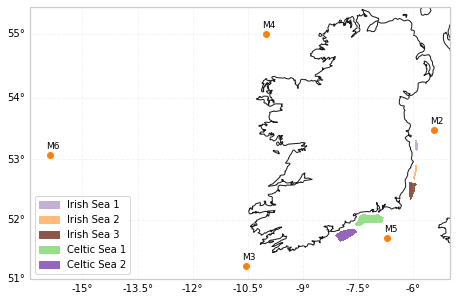
AOI Wind Data Assessment¶
This section demonstrates AOI assessment using 10m wind data provided by all EOOffshore Zarr stores, for the IWB and wind farm coordinates, including:
Mean 10m wind speed
AOI wind speed summary
Wind speed time series
Wind direction (wind roses)
An initial look at 10m wind speed¶
Mean 10m wind speed for all data sets¶
Using Dask, the data set loading process is lazy, where no data is loaded inititally. Instead, data loading is delayed until execution time, where variables will be loaded and processed in parallel according to the corresponding chunks specification. Dask arrays implement a subset of the NumPy ndarray interface using blocked algorithms, and the original variable arrays will be split into smaller chunk arrays, enabling computation on arrays larger than memory using all available cores. The blocked algorithms are coordinated using Dask graphs.
Here, mean 10m wind speed (provided by all data sets) over the time dimension is computed for all grid coordinates in each data set, where Dask graph execution is triggered by calling compute(). The resulting variable values will be contained in a NumPy ndarray.
Graph execution is managed by a task scheduler. The default scheduler (used for executing this notebook) executes computations with local threads. However, execution may also be performed on a distributed cluster without any change to the xarray code used here.
It is important to note here how the combination of the xarray, Dask, and Zarr libraries results in a scalable solution that can be applied to data sets of arbitrary sizes (related to heterogeneous spatial and temporal resolutions), as is the case with the EOOffshore catalog wind data sets. Parallel, out-of-core, computation of underlying variable chunks is achievable with identical calls to the xarray API.
fig, ax = plt.subplots(nrows=2, ncols=3, figsize=(27, 12), subplot_kw=dict(projection=MAP_PROJECTION))
ax = ax.flatten()
for i, eooffshoreds in enumerate(PLOT_ICS_DATASETS):
plot_ics_variable(variable=eooffshoreds.dataset.wind_speed.sel(height=10).mean(dim='time', keep_attrs=True).compute(),
title=f'{eooffshoreds.name} ({format_plot_time(eooffshoreds.dataset.time.min())} - {format_plot_time(eooffshoreds.dataset.time.max())})',
vmin=CUT_IN_WIND_SPEED,
vmax=10.5,
ax=ax[i],
)
fig.suptitle('Mean 10m Wind Speed');

Mean seasonal 10m wind speed¶
If required, seasonal wind speed may be calculated using xarray.DataArray.groupby() with the Season (time.season) dimension (created during EooffshoreDataset initialisation). This is demonstrated using the MÉRA dataset.
MAM = March, April, May
JJA = June, July, August
SON = September, October, November
DJF = December, January, February
season_order = ['MAM', 'JJA', 'SON', 'DJF']
fig, ax = plt.subplots(nrows=2, ncols=2, figsize=(18, 12), subplot_kw=dict(projection=MAP_PROJECTION))
axes = ax.flatten()
seasonws = mera.dataset.wind_speed.sel(height=10).groupby('Season').mean(keep_attrs=True).compute()
for i, season in enumerate(season_order):
ax = axes[i]
plot_ics_variable(ax=ax,
variable=seasonws.sel(Season=season),
title=f'Season = {season}',
vmin=CUT_IN_WIND_SPEED,
vmax=seasonws.max().item())
plt.subplots_adjust(hspace=0.25)
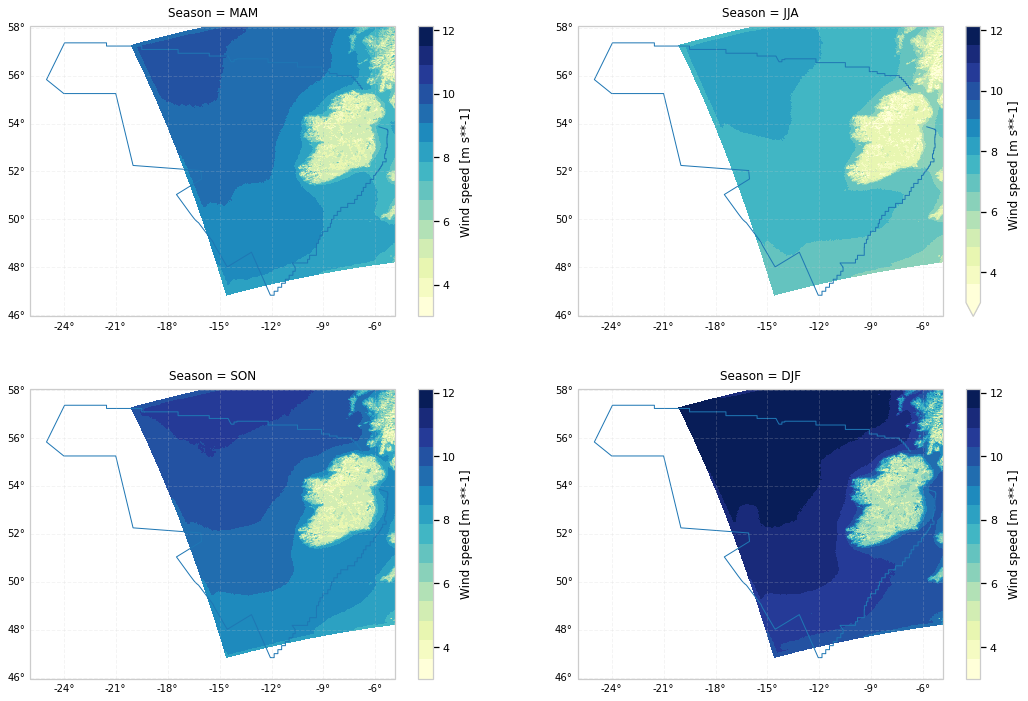
Wind speed summary¶
Here are utility functions used for AOI analysis:
Mean variable summary for provided data sets
Plotting variables over time:
Mean monthly values for provided datasets time period
Mean value per month of year
For wind farm AOIs, data is selected using the nearest lat/lon coordinates according to the regionmask-based mask (see WindfarmEooffshoreDataset above). Spatial mean values are used to represent individual wind farms, i.e. the mean value of all grid coordinates in the wind farm AOI.
def aoi_summary(datasets: List[xr.Dataset], variable: str, height: int):
"""For all AOIs and specified datasets, calculate mean specified variable/height over time"""
def variable_mean(aoids: xr.Dataset):
mean = None
if aoids:
mean = aoids[variable].sel(height=height)
mean = mean.mean(dim='time') if 'time' in mean.dims else mean
mean = mean.values[0]
return mean
all_aoids = [{dataset.name: variable_mean(iwb.buoy_dataset(buoy, dataset)) for dataset in datasets} for buoy in iwb.buoys]
all_aoids += [{dataset.name: variable_mean(eoowindfarmds.windfarm_dataset(windfarm, dataset, spatial_mean=True)) for dataset in datasets} for windfarm in eoowindfarmds.windfarms]
return pd.DataFrame(all_aoids, index=iwb.buoys + eoowindfarmds.windfarms)
def plot_aoi_summary(aoi: str, aoi_datasets: List[xr.Dataset], variable: str, height: int):
"""AOI plots using the specified data sets"""
# Remove any duplicate times prior to concatenation
aoi_variable = xr.concat([ds[variable].sel(height=height, time=~ds.get_index('time').duplicated()) for ds in aoi_datasets],
dim='Dataset',
compat='no_conflicts') # Supports differences in time dimension chunking of underlying Dask arrays
# Use ERA5 long name and units attributes
variable_name = era5.dataset[aoi_variable.name].long_name
title=f"{aoi_variable.height.item():.0f}m {variable_name.title().replace('_', ' ')}"
def update_ax(axp, title, x_label):
axp.set_title(f'{aoi} {title}')
axp.set_xlabel(x_label)
# Use ERA5 long name and units attributes
axp.set_ylabel(f'{variable_name} [{era5.dataset[aoi_variable.name].units}]')
fig, ax = plt.subplots(nrows=1, ncols=2, figsize=(18, 5.5))
plt.subplots_adjust(wspace=0.2)
ax = ax.flatten()
aoi_variable.resample(time='M').mean().plot(hue='Dataset', ax=ax[0]);
update_ax(ax[0], f'{title} (Monthly Mean)', 'Time')
aoi_variable.groupby('time.month').mean().plot(hue='Dataset', ax=ax[1]);
update_ax(ax[1], f'Mean {title} (Month of Year)', 'Month')
Total 10m wind speed observations/values¶
For the Zarr stores, this is computed with xarray.DataArray.count() along the time dimension
count_observations = lambda ds: ds.wind_speed.sel(height=10).count(dim='time').compute().item() if ds else 0
aoi_counts = [{dataset.name: count_observations(iwb.buoy_dataset(buoy, dataset)) for dataset in DATASETS} for buoy in iwb.buoys]
aoi_counts += [{dataset.name: count_observations(eoowindfarmds.windfarm_dataset(windfarm, dataset, spatial_mean=True)) for dataset in DATASETS} for windfarm in eoowindfarmds.windfarms]
pd.DataFrame(aoi_counts, index=iwb.buoys + eoowindfarmds.windfarms).style.format('{:,.0f}')
| ASCAT | CCMP | ERA5 | MÉRA | NEWA | Sentinel-1 | |
|---|---|---|---|---|---|---|
| M2 | 6,628 | 3,072 | 181,872 | 46,752 | 87,648 | 559 |
| M3 | 7,018 | 7,533 | 181,872 | 46,752 | 87,648 | 503 |
| M4 | 6,420 | 6,335 | 181,872 | 46,752 | 87,648 | 796 |
| M5 | 6,923 | 5,664 | 181,872 | 46,752 | 87,648 | 449 |
| M6 | 6,524 | 7,270 | 181,872 | 46,752 | 0 | 0 |
| Irish Sea 1 | 12 | 1,257 | 181,872 | 46,752 | 87,648 | 884 |
| Irish Sea 2 | 2,194 | 1,340 | 181,872 | 46,752 | 87,648 | 1,120 |
| Irish Sea 3 | 4,528 | 3,173 | 181,872 | 46,752 | 87,648 | 1,171 |
| Celtic Sea 1 | 7,016 | 3,660 | 181,872 | 46,752 | 87,648 | 1,057 |
| Celtic Sea 2 | 7,141 | 3,766 | 181,872 | 46,752 | 87,648 | 1,171 |
Mean 10m wind speed (\(ms^{-1}\))¶
nan values indicate no data was found for a particular AOI (see mean map plots above)
aoi_summary(datasets=DATASETS, variable='wind_speed', height=10).style.format('{:.2f}')
| ASCAT | CCMP | ERA5 | MÉRA | NEWA | Sentinel-1 | |
|---|---|---|---|---|---|---|
| M2 | 7.96 | 8.29 | 7.80 | 8.00 | 8.24 | 8.15 |
| M3 | 8.73 | 8.75 | 8.51 | 8.82 | 9.02 | 8.44 |
| M4 | 9.09 | 9.20 | 8.86 | 9.26 | 9.51 | 9.06 |
| M5 | 8.19 | 8.16 | 8.03 | 8.42 | 8.49 | 8.18 |
| M6 | 9.72 | 9.68 | 9.38 | 9.53 | nan | nan |
| Irish Sea 1 | 9.41 | 7.53 | 6.36 | 7.38 | 7.49 | 6.93 |
| Irish Sea 2 | 8.15 | 7.72 | 6.42 | 7.49 | 7.70 | 6.91 |
| Irish Sea 3 | 7.96 | 8.03 | 7.07 | 7.75 | 7.90 | 7.15 |
| Celtic Sea 1 | 7.86 | 8.02 | 6.93 | 8.04 | 8.03 | 7.05 |
| Celtic Sea 2 | 7.97 | 8.12 | 7.18 | 8.08 | 8.14 | 7.15 |
Wind speed time series¶
10m wind speed since 2001 for IWB buoys¶
Using the M2 buoy as an example IWB AOI, the following plots are generated
Time series of monthly mean wind speed
Mean wind speed for each month, highlighting seasonal differences for an AOI.
def plot_buoy_aoi_summary(buoy: str, datasets: List[xr.Dataset], variable: str, height: int):
"""IWB buoy AOI plots using the specified data sets"""
plot_aoi_summary(aoi=buoy,
aoi_datasets=[iwb.buoy_dataset(buoy, d) for d in datasets],
variable=variable,
height=height)
plot_buoy_aoi_summary(buoy='M2', datasets=DATASETS, variable='wind_speed', height=10)
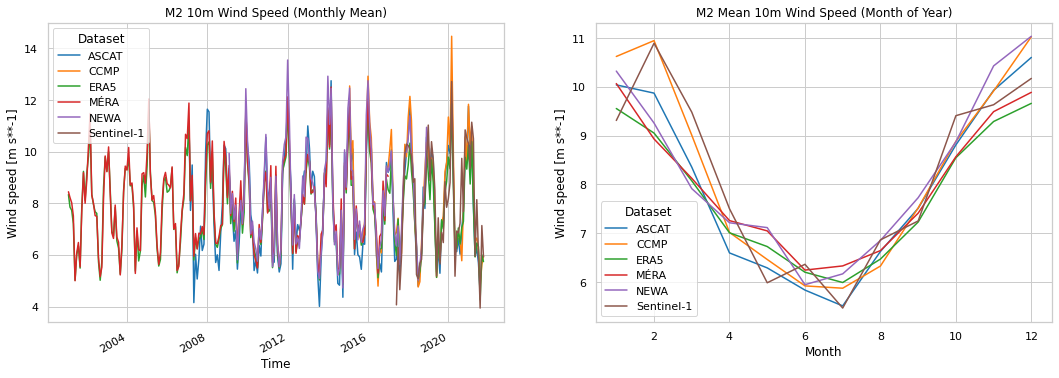
10m wind speed since 2001 for wind farms¶
Similar time series plots for wind farm AOIs are generated here, using the Celtic Sea 1 wind farm as an example AOI
Each mean wind speed is calculated as the corresponding spatial mean across the wind farm grid coordinates
def plot_windfarm_aoi_summary(windfarm: str, datasets: List[xr.Dataset], variable: str, height: int):
"""Wind farm AOI plots using the specified data sets"""
plot_aoi_summary(aoi=windfarm,
aoi_datasets=[eoowindfarmds.windfarm_dataset(windfarm, d, spatial_mean=True) for d in datasets],
variable=variable,
height=height)
plot_windfarm_aoi_summary(windfarm='Celtic Sea 1', datasets=DATASETS, variable='wind_speed', height=10)
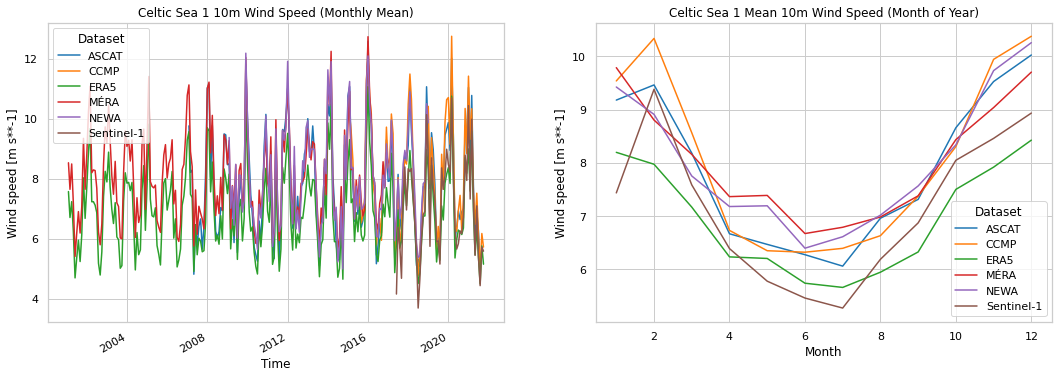
Wind direction¶
Wind direction is typically used to generate wind rose plots, which visualise wind speed distributions in direction sectors. Here, the windrose library is used to create AOI plots for 30 degree direction sectors, each containing stacked wind speed histograms.
# The windrose projection doesn't render bars correctly unless at least one polar projection plot has been created
# For now, this placeholder appears to be sufficient for subsequent correct rendering
N = 1
theta = np.linspace(0.0, 2 * np.pi, N, endpoint=False)
radii = 10 * np.random.rand(N)
width = np.pi / 4 * np.random.rand(N)
ax = plt.subplot(111, projection='polar')
bars = ax.bar(theta, radii, width=width, bottom=0.0)
plt.close()
# <end placeholder>
def plot_aoi_windrose(aoi: str, aoi_datasets: List[xr.Dataset], height: int):
"""Create an AOI wind rose plot for the specified data sets"""
fig, axes = plt.subplots(nrows=2, ncols=3, figsize=(20, 10), subplot_kw=dict(projection="windrose", rmax=25))
plt.subplots_adjust(wspace=0.1, hspace=0.3)
axes = axes.flatten()
bins = np.arange(0, 25, 5)
for i, ds in enumerate(aoi_datasets):
ds = ds.sel(height=height)
ax = axes[i]
ax.bar(direction=ds.wind_direction.values.reshape(-1,),
var=ds.wind_speed.values.reshape(-1,),
nsector=12,
bins=bins,
normed=True,
opening=0.8,
edgecolor='white',
cmap=plt.cm.YlGnBu)
ax.set_legend(decimal_places=0, title=era5.dataset.wind_speed.units, title_fontsize='small', loc='lower right')
labels = ax.get_legend().get_texts()
for i in range(0, len(bins)-1):
labels[i].set_text(f'{bins[i]} - {bins[i+1]}')
labels[-1].set_text(f'{bins[-1]}+')
ax.set_title(f'{ds.Dataset.item()}');
fig.suptitle(f'{aoi} {height}m wind roses');
10m wind roses for IWB buoys¶
Using the M2 buoy as an example IWB AOI
def plot_buoy_windroses(buoy: str, height: int):
plot_aoi_windrose(aoi=buoy, aoi_datasets=[iwb.buoy_dataset(buoy, d) for d in DATASETS], height=height)
plot_buoy_windroses(buoy='M2', height=10)

10m wind roses for wind farms¶
Using the Celtic Sea 1 wind farm as an example AOI
def plot_windfarm_windroses(buoy: str, height: int):
plot_aoi_windrose(aoi=buoy, aoi_datasets=[eoowindfarmds.windfarm_dataset(buoy, d) for d in DATASETS], height=height)
plot_windfarm_windroses(buoy='Celtic Sea 1', height=10)
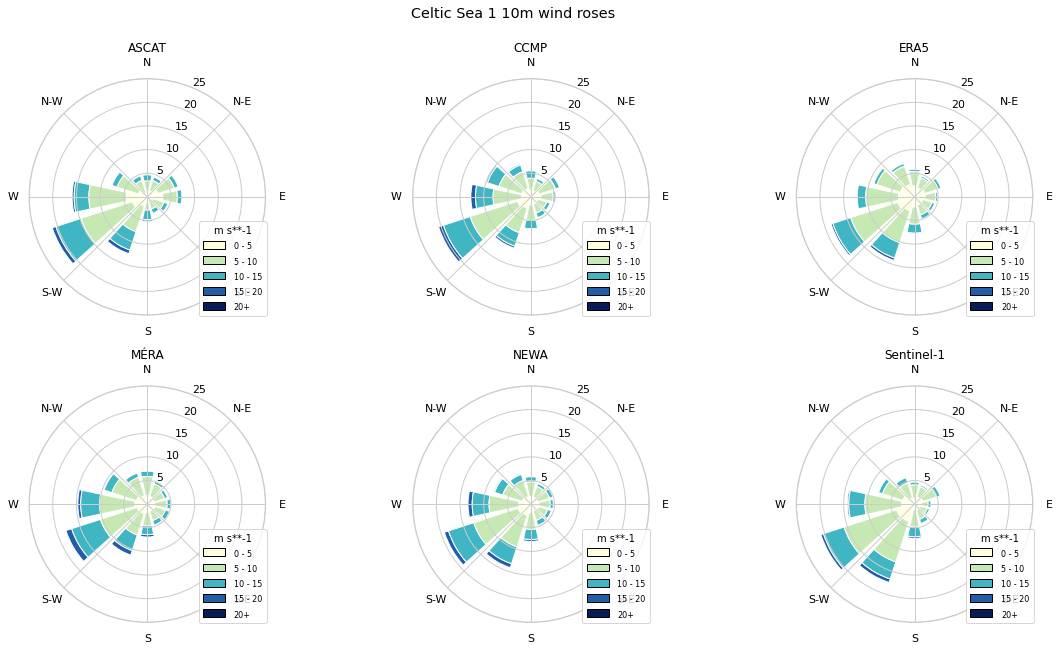
Wind Speed Extrapolation¶
Wind speed extrapolation is the process of extrapolating data values at provided heights to one or more required heights for which data is unavailable, generating a wind speed profile at an AOI. For satellite or reanalysis, data is usually restricted to values at 10m above the surface level. Consequently, extrapolation may be used with these 10m data to generate wind speed values at typical wind turbine hub heights. The following publications provide examples of wind speed extrapolation:
This section is not intended to be a complete analysis of possible extrapolation methods. Instead, its objective is to demonstrate how it may be implemented using the scalable approach offered by the combination of the xarray, Dask and Zarr libraries.
Power law extrapolation¶
The Comparison of Offshore Wind Speed Extrapolation and Power Density Estimation notebook demonstrates the comparison of wind speed extrapolation methods using the EOOffshore catalog, where the associated metrics have identified the power law method as suitable for extrapolating 10m wind speed to hub heights. This approach has also been used in previous analysis, (for example, Remmers et al., 2019; Schelbergen et al., 2020). It is defined as follows (Hsu et al., 1994 - Determining the Power-Law Wind-Profile Exponent under Near-Neutral Stability Conditions at Sea):
\(u = u_r\left(\dfrac{z}{z_r}\right)^\alpha\)
\(u\): wind speed (\(m s^{-1}\)) at required height \(z\) (\(m\))
\(z_r\): reference height (e.g. 10m for data provided by ERA5, Sentinel-1 etc.)
\(u_r\): wind speed at \(z_r\)
\(\alpha\): function of atmospheric stability and surface characteristics
Here are some utility classes providing an implementation of power law extrapolation that will operate on the EOOffshore Zarr stores.
class Extrapolator(ABC):
"""Base Extrapolator class"""
@abstractmethod
def extrapolate(self, ds: xr.Dataset, variable_name: str, heights: list[int]):
"""Extrapolate data set variable to required heights"""
pass
def _add_extrapolated_variable(self, ds: xr.Dataset, variable_name: str, extrapolated: dict, reindex_height: bool, variable_attrs: dict={}) -> xr.Dataset:
"""Adds extrapolated values to existing variable, at height, and returns an updated Dataset"""
height_attrs = ds.height.attrs
ea = xr.concat([vda.assign_coords(height=height).expand_dims(['height']) for height, vda in extrapolated.items()], dim='height').sortby('height')
if reindex_height:
ds = ds.reindex({'height': ea.height}).chunk({'height':1})
ds[variable_name] = ea
# Height attributes are overwritten, restore them now
ds.height.attrs.update(height_attrs)
if variable_attrs:
ds[variable_name].attrs.update(variable_attrs)
return ds
class WindSpeedExtrapolator(Extrapolator):
"""Base wind speed Extrapolator class"""
def extrapolate(self, ds: xr.Dataset, heights: list[int], variable_name: str = 'wind_speed'):
"""Extrapolate wind speed to required heights"""
# Retain pre-existing height if required
extrapolated_wind_speed = {height: ds[variable_name].sel(height=height) for height in ds.height.values if height not in heights}
# Extrapolate to other heights
for height in [h for h in heights if h not in extrapolated_wind_speed]:
extrapolated_wind_speed[height] = self._extrapolate_wind_speed(ds=ds, variable_name=variable_name, extrapolation_height=height, reference_height=10)
# Reindex height dimension if required
reindex_height = len([h for h in heights if h not in ds.height.values]) > 0
return self._add_extrapolated_variable(ds, variable_name, extrapolated_wind_speed, reindex_height=reindex_height)
@abstractmethod
def _extrapolate_wind_speed(self, ds: xr.Dataset, variable_name, extrapolation_height: int, reference_height: int) -> xr.DataArray:
"""Wind speed extrapolation method implementation"""
pass
@dataclass
class PowerLawWindSpeedExtrapolator(WindSpeedExtrapolator):
"""Wind speed Extrapolator implementation, using the power law method"""
alpha: float = 0.11 # Hsu 1994
def __init__(self, alpha: float=0.11):
self.alpha = alpha
def _extrapolate_wind_speed(self, ds: xr.Dataset, variable_name: str, extrapolation_height: int, reference_height: int) -> xr.DataArray:
"""Wind speed extrapolation method implementation"""
return ds[variable_name].sel(height=reference_height) * (extrapolation_height/reference_height)**self.alpha
Power law \(\alpha\) estimation¶
A value of \(\alpha\) = 0.1 or 0.11 is often used as a good approximation for use at sea with the power law method (Hsu et al., 1994). However, metrics generated by the Comparison of Offshore Wind Speed Extrapolation and Power Density Estimation notebook suggest that an alternative \(\alpha\) value may be more suitable. The ERA5 data set provides wind speed at both 10m and 100m, which may be used to calculate \(\alpha\) as follows:
\(\alpha = \dfrac{\mathrm{ln}\left(\dfrac{u_2}{u_1}\right)}{\mathrm{ln}\left(\dfrac{z_2}{z_1}\right)}\)
\(z_1\): height 1, e.g. 10m
\(z_2\): height 2, e.g. 100m
\(u_1\): wind speed (\(m s^{-1}\)) at height \(z_1\), e.g. ERA5 10m wind speed
\(u_2\): wind speed (\(m s^{-1}\)) at height \(z_2\), e.g. ERA5 100m wind speed
Here, the following are computed:
An ERA5
powerlaw_alphavariable, computed at each time for all grid coordinates. This will be used for extrapolating ERA5 10m wind speed to heights other than 100m.A power law extrapolator with \(\alpha\) = mean ERA5
powerlaw_alpha.
Note:
xarray provides implementations of certain NumPy universal functions (ufunc), including
xarray.ufuncs.log()as used to calculate \(\alpha\). Using ufuncs ensures that lazy computation applies, i.e. the corresponding Dask graph execution does not occur untilcompute()is called.
era5.dataset['powerlaw_alpha'] = (xr.ufuncs.log(era5.dataset.wind_speed.sel(height=100)/era5.dataset.wind_speed.sel(height=10))/math.log(100/10))
mean_era5_alpha_powerlaw_extrapolator = PowerLawWindSpeedExtrapolator(alpha=era5.dataset.powerlaw_alpha.mean().compute().item())
Extrapolation to required hub heights¶
The required hub heights are those featured in the Sustainable Energy Authority of Ireland (SEAI) 2013 wind atlas (UK Met Office, 2015 - Remodelling the Irish national onshore and offshore wind atlas). Power law \(\alpha\) values are motivated by the findings in the Comparison of Offshore Wind Speed Extrapolation and Power Density Estimation notebook. No extrapolation is performed for MÉRA and NEWA as they provide data at multiple heights.
hub_heights = [20, 30, 40, 50, 75, 100, 125, 150]
ascat.dataset = mean_era5_alpha_powerlaw_extrapolator.extrapolate(ds=ascat.dataset, heights=hub_heights)
ccmp.dataset = mean_era5_alpha_powerlaw_extrapolator.extrapolate(ds=ccmp.dataset, heights=hub_heights)
era5.dataset = PowerLawWindSpeedExtrapolator(alpha=era5.dataset.powerlaw_alpha).extrapolate(ds=era5.dataset, heights=hub_heights)
sentinel1.dataset = PowerLawWindSpeedExtrapolator().extrapolate(ds=sentinel1.dataset, heights=hub_heights)
AOI wind profiles¶
Wind profile plots are used to visualise mean wind speed at multiple heights for an AOI. Here, wind profiles are generated for each IWB buoy and wind farm AOI using the extrapolated or provided wind speeds.
Note:
Wind farm mean wind speeds are calculated as the corresponding spatial mean across the wind farm grid coordinates
The ASCAT wind profile for the Irish Sea 1 AOI appears to be an outlier. This is likely related to the low number of observations for this AOI (see above). ASCAT wind quality flags are described in the ASCAT Wind Data for Irish Continental Shelf region notebook.
all_aoi_datasets = [(buoy, [iwb.buoy_dataset(buoy, d) for d in DATASETS]) for buoy in iwb.buoys]
all_aoi_datasets += [(windfarm, [eoowindfarmds.windfarm_dataset(windfarm, d, spatial_mean=True) for d in DATASETS]) for windfarm in eoowindfarmds.windfarms]
mean_windspeed_df = lambda aoids: aoids.wind_speed.mean(dim='time').to_dataframe().reset_index() if aoids else None
profiledf = None
for aoi, aoi_datasets in all_aoi_datasets:
aoidf = pd.concat([mean_windspeed_df(d) for d in aoi_datasets])[['Dataset', 'height', 'wind_speed']]
aoidf['AOI'] = aoi
profiledf = pd.concat((profiledf, aoidf), ignore_index=True)
hue='Dataset'
g = sns.relplot(data=profiledf,
kind='line',
col='AOI',
col_wrap=5,
x='wind_speed',
y='height',
markers=True,
style=hue,
hue=hue,
)
(g.set(xlim=(5.5, 13.5), yticks=profiledf.height.unique())
.set_titles('{col_name}')
.set_xlabels(f'{era5.dataset.wind_speed.long_name} [{era5.dataset.wind_speed.units}]')
.set_ylabels(f'{era5.dataset.height.long_name} [{era5.dataset.height.units}]')
)
g.fig.subplots_adjust(hspace=0.15, wspace=0.15)
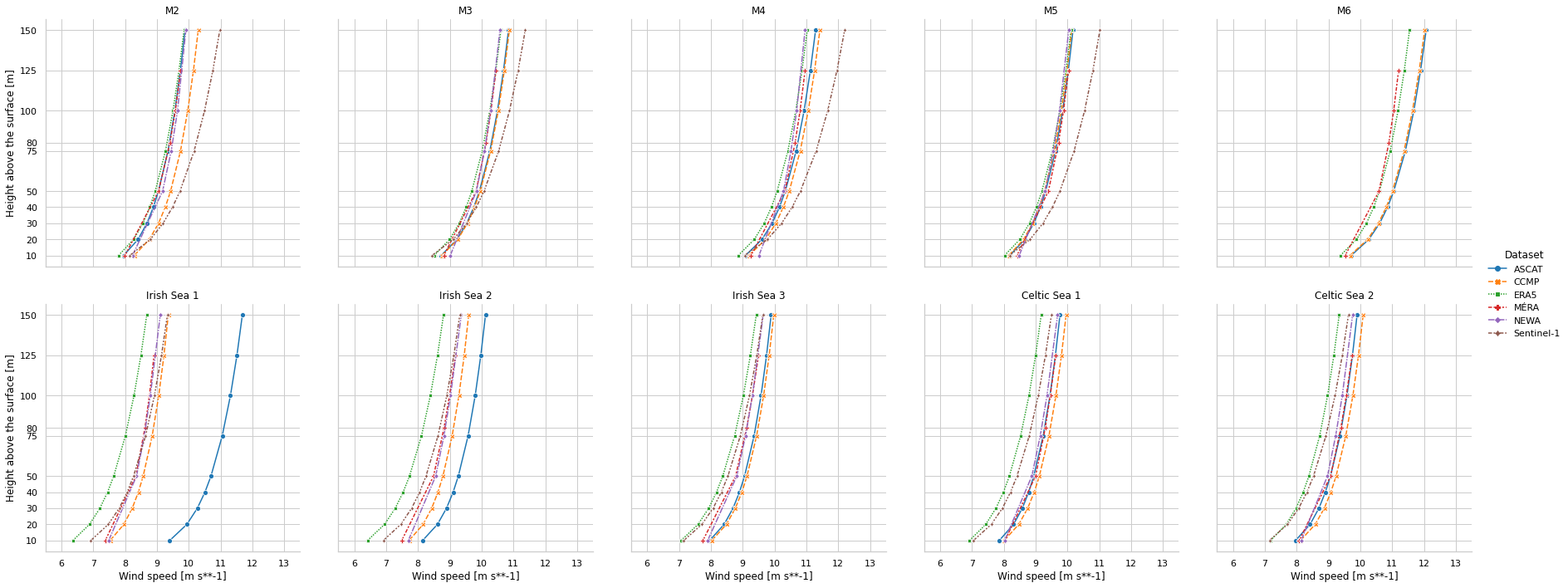
Power Density Estimation¶
Offshore wind power density estimates may be generated for an AOI using the available wind speed values at the corresponding coordinates. When used in combination with wind speed extrapolation as described above, it is possible to estimate power at typical wind turbine hub heights. The following publications provide examples of power density estimation using wind speed:
Badger et al. (2016) - Extrapolating Satellite Winds to Turbine Operating Heights
Ahsbahs et al. (2020) - US East Coast synthetic aperture radar wind atlas for offshore wind energy
AOI wind speed distributions and Weibull parameters¶
AOI wind speed is typically represented by a Weibull distribution of observations, characterized by a shape parameter (\(k\), dimensionless) and a scale parameter (\(\lambda\), \(m s^{-1}\)) (Ahsbahs et al., 2020). The Weibull probability density function (PDF) is as follows:
\(\mathrm{PDF}(U) = \dfrac{k}{\lambda}\left(\dfrac{U}{k} \right)^{k-1} \epsilon^{-(U/\lambda)^k}\)
A minimum number of observations or samples are required for Weibull parameter fitting, this is relevant for SAR data such as the Sentinel-1 data set. Consequently, wind speeds from all directional sectors have been used for fitting (Badger et al., 2016), where the same process is applied in this notebook to each EOOffshore data set.
Here are some utility functions that plot AOI wind speed distributions and corresponding Weibull PDFS for all data sets, where the Weibull parameters have been fit using scipy.stats.weibull_min().
def weibull_fit(data: np.array):
"""Fit Weibull parameters using scipy"""
# Known issues with `loc` parameter: https://github.com/scipy/scipy/issues/11806
for loc in [1, 0]:
shape, loc, scale = weibull_min.fit(data, loc=loc)
# Occasionally, loc=1 results in an inaccurate fit:
# Try other loc=x appears to generate an appropriate fit
if shape > 1.85 and shape < 10:
break
return shape, loc, scale
def plot_aoi_weibull(aoi: str, aoi_datasets: List[xr.Dataset], height: int):
"""Plot AOI Weibull fits and wind speed distributions for specified data sets"""
windspeed_df = pd.concat([d.wind_speed.sel(height=height).to_dataframe().reset_index() if d else None for d in aoi_datasets], ignore_index=True)[['Dataset', 'wind_speed']].dropna()
# Don't want to share y-axis in FacetGrid as there can be differences in number of observations per dataset
g = sns.displot(windspeed_df, x='wind_speed', stat='density', hue='Dataset', col='Dataset', col_wrap=3, legend=False, facet_kws=dict(sharey=False))
dataset_proportions = (windspeed_df.groupby('Dataset').size() / len(windspeed_df)).to_dict()
for i, dataset in enumerate(windspeed_df.Dataset.unique()):
dataset_windspeed = windspeed_df[windspeed_df.Dataset==dataset].wind_speed.values
shape, loc, scale = weibull_fit(dataset_windspeed)
sorted_windspeed = sorted(dataset_windspeed)
ax = g.axes[i]
ax.plot(sorted_windspeed, weibull_min.pdf(sorted_windspeed, shape, loc, scale) * dataset_proportions[dataset], 'r-', lw=2, alpha=0.6)
ax.set_title(f'{dataset} ($k$ = {shape:.2f}, $\lambda$ = {scale:.2f})')
ax.set_xlabel(f'{era5.dataset.wind_speed.long_name} [{era5.dataset.wind_speed.units}]')
ax.legend(['Weibull fit', dataset])
def plot_buoy_weibull(buoy: str, height: int):
"""Plot IWB buoy AOI Weibull fits and wind speed distributions"""
plot_aoi_weibull(aoi=buoy, aoi_datasets=[iwb.buoy_dataset(buoy, d) for d in DATASETS], height=height)
def plot_windfarm_weibull(windfarm: str, height: int):
"""Plot wind farm AOI Weibull fits and wind speed distributions"""
# Spatial mean wind speed is used for MÉRA and NEWA to reduce computation prior to Weibull fit
datasets = [(ascat, False),
(ccmp, False),
(era5, False),
(mera, True),
(newa, True),
(sentinel1, False)
]
plot_aoi_weibull(aoi=windfarm, aoi_datasets=[eoowindfarmds.windfarm_dataset(windfarm, d, spatial_mean=spatial_mean) for d, spatial_mean in datasets], height=height)
10m wind speed distributions and Weibull parameters for IWB buoys¶
Using the M2 buoy as an example IWB AOI
plot_buoy_weibull(buoy='M2', height=10)

10m wind speed distributions and Weibull parameters for wind farms¶
Using the Celtic Sea 1 wind farm as an example AOI
plot_windfarm_weibull(windfarm='Celtic Sea 1', height=10)
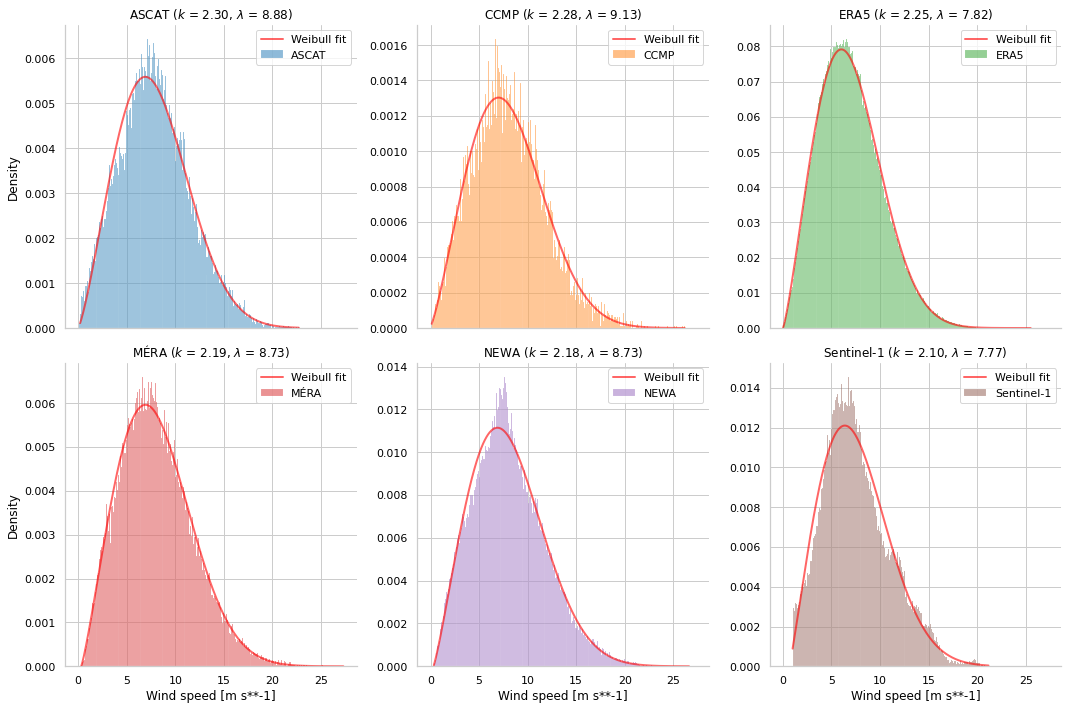
Estimation implementation¶
Power density estimation at multiple heights is implemented as an Extrapolator, as used for wind speed extrapolation above. Here is the base class used for all implementations.
class PowerDensityEstimator(Extrapolator):
"""Base power density estimator class, implemented as an Extrapolator to reuse the creation of new variables with height dimension"""
attrs: dict[str, str] = {
'long_name': 'Power density (estimate)',
'units': 'Wm**-2'
}
min_wind_speed: float = CUT_IN_WIND_SPEED
max_wind_speed: float = CUT_OUT_WIND_SPEED
wind_speed_variable_name: str = 'wind_speed'
def __init__(self, air_density: float=1.225):
self.air_density = air_density
def extrapolate(self, ds: xr.Dataset, heights: list[int], variable_name: str = 'power_density'):
"""Estimate power density at required heights"""
estimated_power_density = {height: self._estimate_power_density(wind_speed=self._filter_wind_speed(ds[self.wind_speed_variable_name].sel(height=height)))
for height in heights}
return self._add_extrapolated_variable(ds, variable_name, estimated_power_density, reindex_height=False, variable_attrs=self.attrs)
def _filter_wind_speed(self, wind_speed: xr.DataArray):
"""Filters to turbine cut in/out range"""
return wind_speed.where((wind_speed >= self.min_wind_speed) & (wind_speed <= self.max_wind_speed))
@abstractmethod
def _estimate_power_density(self, wind_speed: xr.DataArray) -> xr.DataArray:
"""Power density estimation implementation"""
pass
Weibull parameters for all coordinates¶
Mean wind power density is related to the corresponding Weibull parameters as follows (Ahsbahs et al., 2020):
\(P = \dfrac{1}{2}\rho \lambda^3 \Gamma \left(1 + \dfrac{3}{k}\right)\)
\(P\): wind power density (\(W m^{-2}\))
\(U\): wind speed (\(m s^{-1}\))
\(\rho\): air density (\(kg\) \(m^{-3}\)), a default value of 1.225 is typically used over oceans
\(\Gamma\): gamma function (
scipy.special.gamma()is used in this notebook)\(k\): Weibull shape parameter (dimensionless)
\(\lambda\): Weibull scale parameter (\(m s^{-1}\))
Using the scipy.stats.weibull_min() implementation for Weibull parameter fitting, as described above, is sufficient for individual AOI assessment. This approach does not scale well, preventing Weibull parameter fitting for all grid coordinates in data sets with high spatial resolutions. However, Justus et al., 1976 (Methods for Estimating Wind Speed Frequency Distributions) proposed parameter estimation as follows, which has been used with Sentinel-1 wind speed data (de Montera et al., 2020)
\(k = \left(\dfrac{\sigma}{\mu} \right)^{-1.086}\)
\(\lambda = \dfrac{\mu}{\Gamma \left(\frac{1}{k} + 1 \right)}\)
\(\mu\): mean wind speed (\(m s^{-1}\))
\(\sigma\): wind speed standard deviation (\(m s^{-1}\))
This approach can be implemented using xarray’s lazy computation, where the corresponding Dask graph execution does not occur until compute() is called, and will scale to accomodate all data sets in the EOOffshore catalog.
class WeibullWindSpeedPowerDensityEstimator(PowerDensityEstimator):
"""Power density estimation using Weibull parameters"""
def _filter_wind_speed(self, wind_speed: xr.DataArray):
"""Filters to turbine cut in/out range"""
# No filtering is performed prior to Weibull parameter fitting
return wind_speed
def _estimate_power_density(self, wind_speed: xr.DataArray) -> xr.DataArray:
"""Power density estimation implementation"""
shape, scale = self.fit_parameters(wind_speed)
return 0.5 * self.air_density * (scale**3) * gamma(1+(3/shape))
def fit_parameters(self, wind_speed: xr.DataArray) -> Tuple[xr.DataArray, xr.DataArray]:
"""Fit Weibull parameters"""
# As used in de Montera et al., 2020
mean_wind_speed = wind_speed.mean(dim='time')
shape = (wind_speed.std(dim='time')/mean_wind_speed)**-1.086
scale = mean_wind_speed / gamma((1/shape)+1)
return shape, scale
Create Weibull shape and scale parameters for all data sets
weibull_power_estimator = WeibullWindSpeedPowerDensityEstimator()
for d in PLOT_ICS_DATASETS:
weibull_shape, weibull_scale = weibull_power_estimator.fit_parameters(d.dataset.wind_speed)
weibull_shape.attrs = {'units': 'dimensionless', 'long_name': 'Weibull shape (k)'}
weibull_scale.attrs = {'units': d.dataset.wind_speed.units, 'long_name': 'Weibull scale ($\lambda$)'}
d.dataset['weibull_shape'] = weibull_shape
d.dataset['weibull_scale'] = weibull_scale
10m Weibull shape (k) parameter¶
fig, ax = plt.subplots(nrows=2, ncols=3, figsize=(27, 12), subplot_kw=dict(projection=MAP_PROJECTION))
ax = ax.flatten()
for i, eooffshoreds in enumerate(PLOT_ICS_DATASETS):
plot_ics_variable(variable=eooffshoreds.dataset.weibull_shape.sel(height=10).compute(),
title=f'{eooffshoreds.name} ({format_plot_time(eooffshoreds.dataset.time.min())} - {format_plot_time(eooffshoreds.dataset.time.max())})',
vmin=1.9,
vmax=2.6,
ax=ax[i],
cmap=plt.cm.get_cmap('inferno_r', 8)
)
fig.suptitle('10m Weibull Shape');
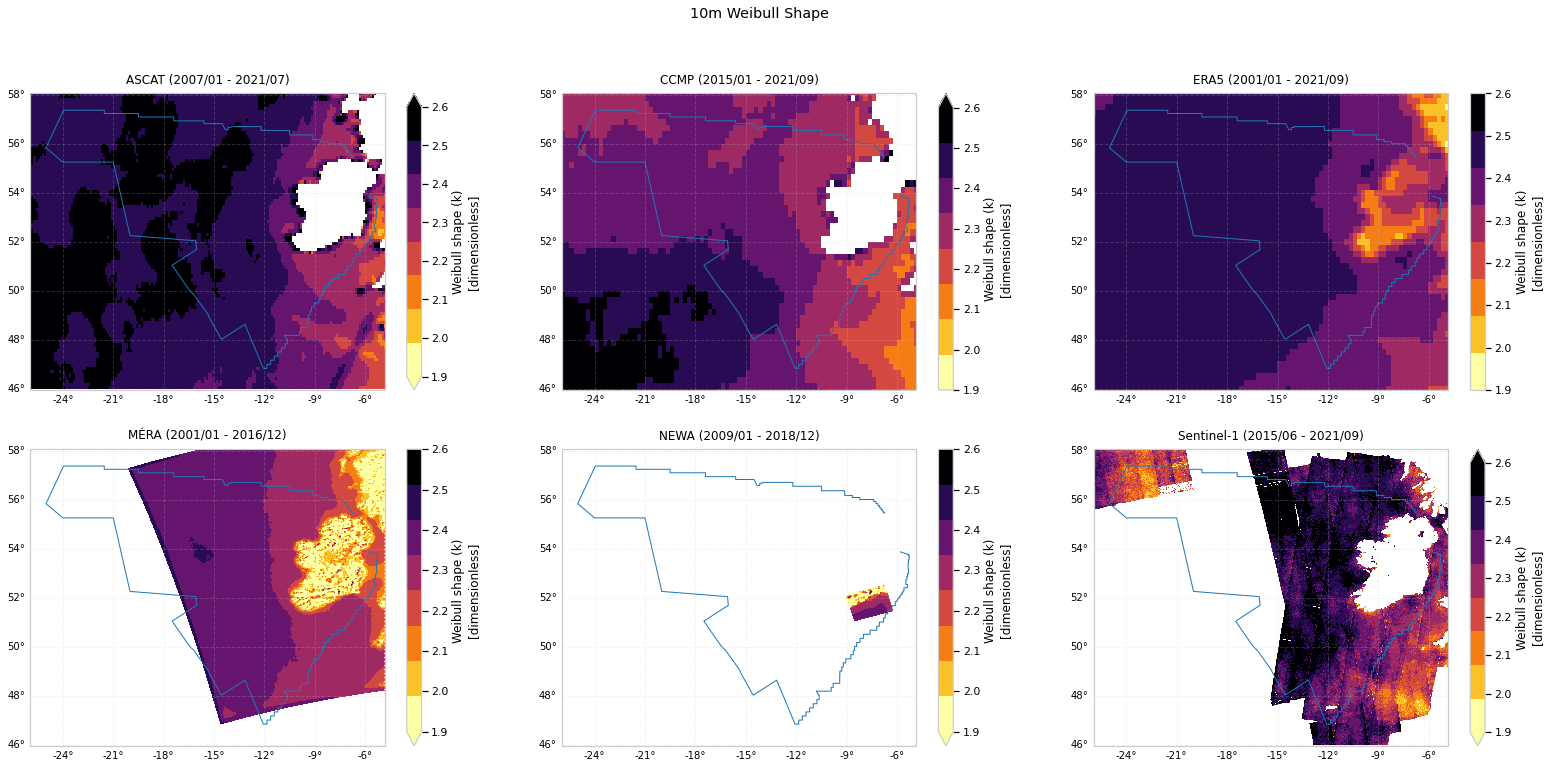
10m Weibull scale (\(\lambda\)) parameter¶
fig, ax = plt.subplots(nrows=2, ncols=3, figsize=(27, 12), subplot_kw=dict(projection=MAP_PROJECTION))
ax = ax.flatten()
for i, eooffshoreds in enumerate(PLOT_ICS_DATASETS):
plot_ics_variable(variable=eooffshoreds.dataset.weibull_scale.sel(height=10).compute(),
title=f'{eooffshoreds.name} ({format_plot_time(eooffshoreds.dataset.time.min())} - {format_plot_time(eooffshoreds.dataset.time.max())})',
vmin=6,
vmax=12,
ax=ax[i],
cmap=plt.cm.get_cmap('inferno_r', 6)
)
fig.suptitle('10m Weibull Scale');
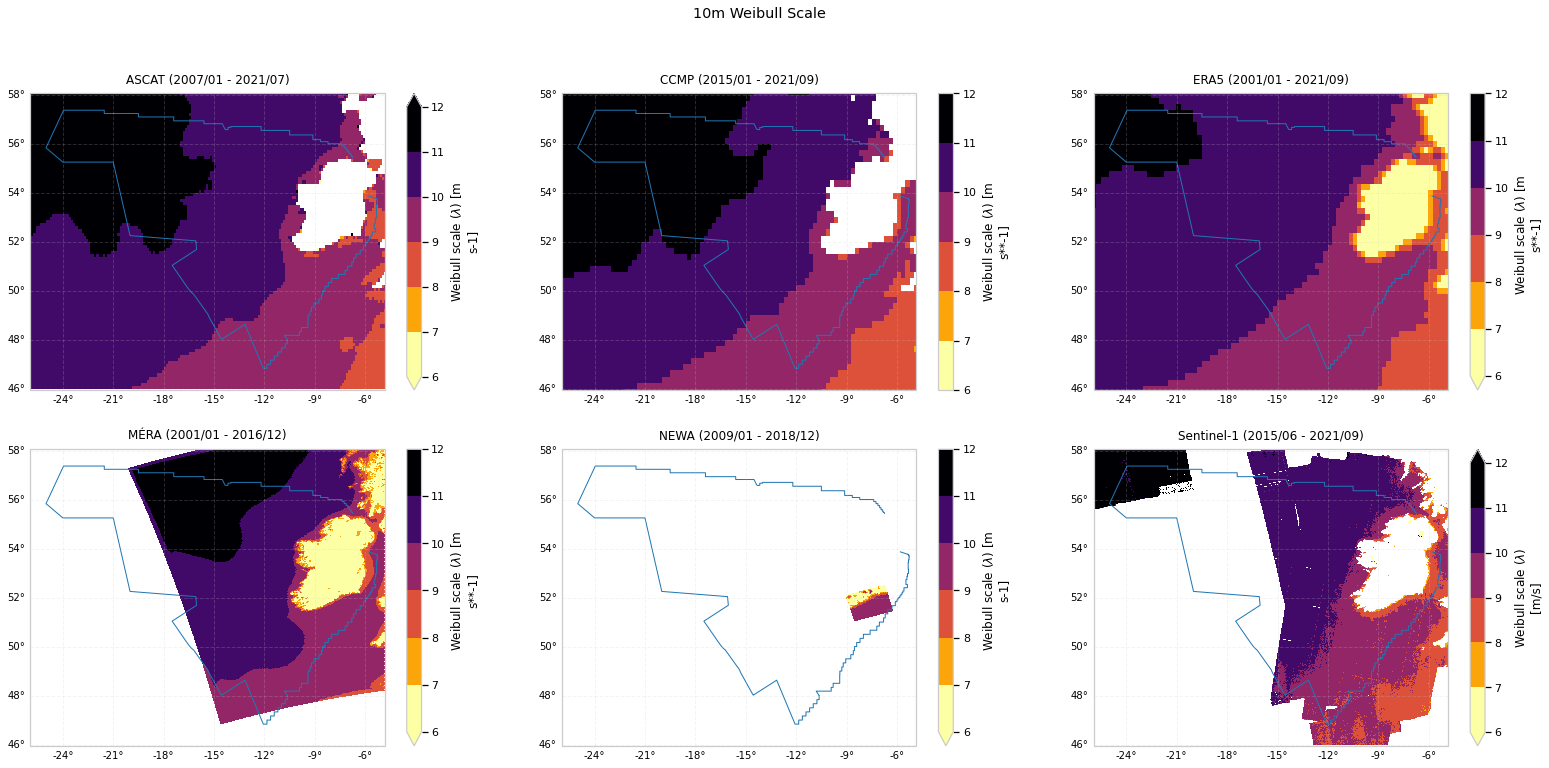
Power density estimation using cubed wind speed¶
When a data set provides a complete time series of wind speed observations, power density may be estimated from the cube of the wind speed (de Montera et al., 2020):
\(P = \dfrac{1}{2}\rho U^3\)
\(P\): wind power density (\(W m^{-2}\))
\(\rho\): air density (\(kg\) \(m^{-3}\)), a default value of 1.225 is typically used over oceans
\(U\): wind speed (\(m s^{-1}\))
class CubedWindSpeedPowerDensityEstimator(PowerDensityEstimator):
"""Power density estimation using complete wind speed time series"""
def _estimate_power_density(self, wind_speed: xr.DataArray) -> xr.DataArray:
"""Power density estimation implementation"""
return 0.5 * self.air_density * (wind_speed**3)
Estimation at required hub heights¶
Similar to extrapolation above, power density is estimated at required hub heights for all EOOffshore catalog data sets.
The wind time series cube method is used for all data sets apart from Sentinel-1. As the latter does not provide a complete observation time series, the Weibull method is used instead.
No estimation is performed for NEWA as it provides power data at multiple heights.
cubed_windspeed_estimator = CubedWindSpeedPowerDensityEstimator()
weibull_power_estimator = WeibullWindSpeedPowerDensityEstimator()
for d, estimator in [(ascat, cubed_windspeed_estimator),
(ccmp, cubed_windspeed_estimator),
(era5, cubed_windspeed_estimator),
(mera, cubed_windspeed_estimator),
(sentinel1, weibull_power_estimator),
]:
d.dataset = estimator.extrapolate(ds=d.dataset, heights=d.dataset.height.values)
100m power density for all data sets¶
fig, ax = plt.subplots(nrows=2, ncols=3, figsize=(27, 12), subplot_kw=dict(projection=MAP_PROJECTION))
ax = ax.flatten()
height = 100
for i, eooffshoreds in enumerate(PLOT_ICS_DATASETS):
power_density = eooffshoreds.dataset.power_density.sel(height=height)
power_density = power_density.mean(dim='time', keep_attrs=True) if 'time' in power_density.dims else power_density
plot_ics_variable(variable=power_density.compute(),
title=f'{eooffshoreds.name} ({format_plot_time(eooffshoreds.dataset.time.min())} - {format_plot_time(eooffshoreds.dataset.time.max())})',
vmin=400,
vmax=1900,
ax=ax[i],
cmap=plt.cm.get_cmap('inferno_r', 10)
)
fig.suptitle(f'{height}m Power Density');
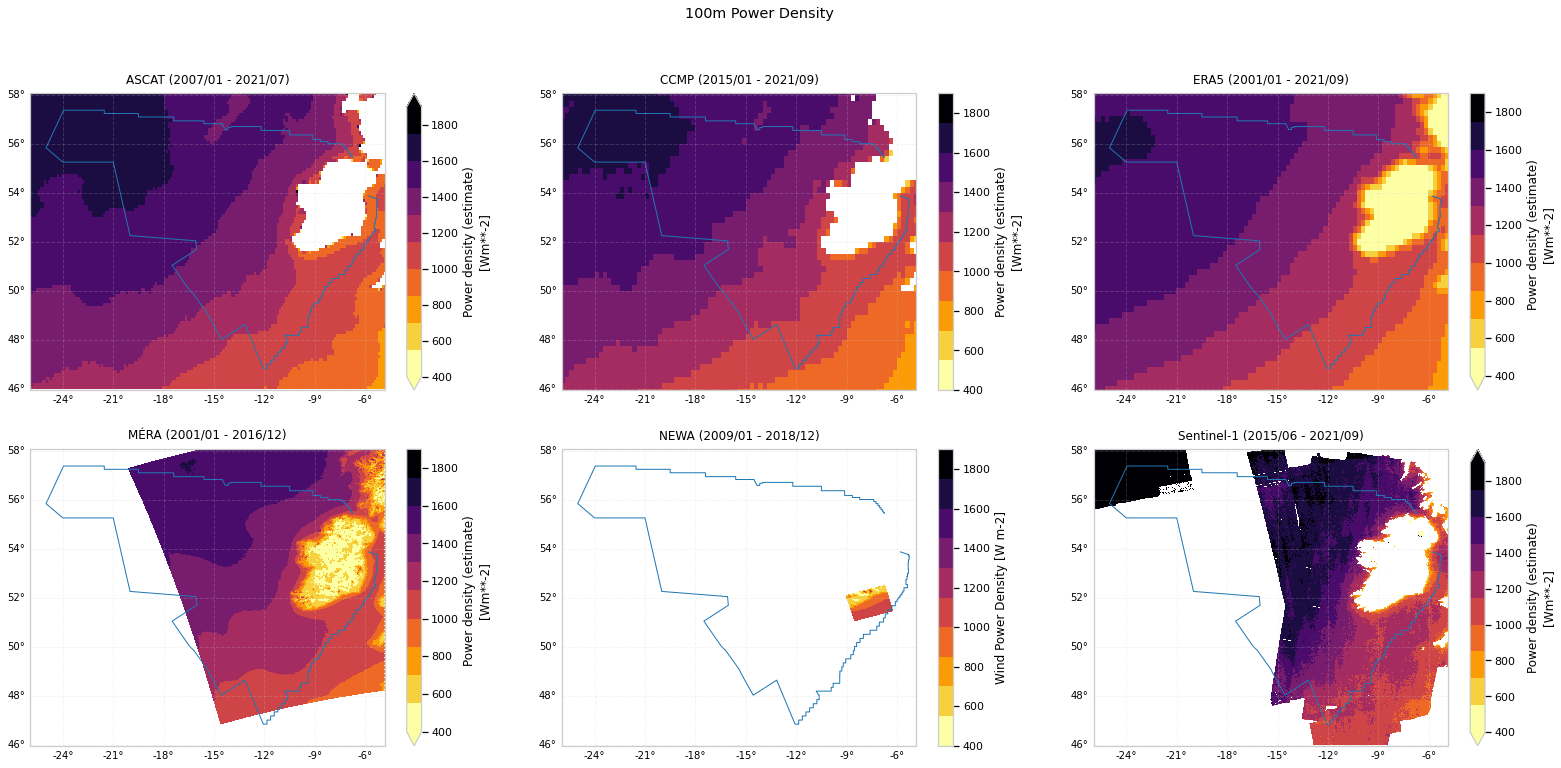
Seasonal 100m power density¶
Similiar to seasonal wind speed described above, seasonal power density may be calculated using xarray.DataArray.groupby() with the Season (time.season) dimension. This is demonstrated using the MÉRA dataset.
fig, ax = plt.subplots(nrows=2, ncols=2, figsize=(18, 12), subplot_kw=dict(projection=MAP_PROJECTION))
axes = ax.flatten()
seasonws = mera.dataset.power_density.sel(height=100).groupby('Season').mean(keep_attrs=True).compute()
for i, season in enumerate(season_order):
ax = axes[i]
plot_ics_variable(ax=ax,
variable=seasonws.sel(Season=season),
title=f'Season = {season}',
vmin=400,
vmax=seasonws.max().item(),
cmap=plt.cm.get_cmap('inferno_r', 10))
plt.subplots_adjust(hspace=0.25)
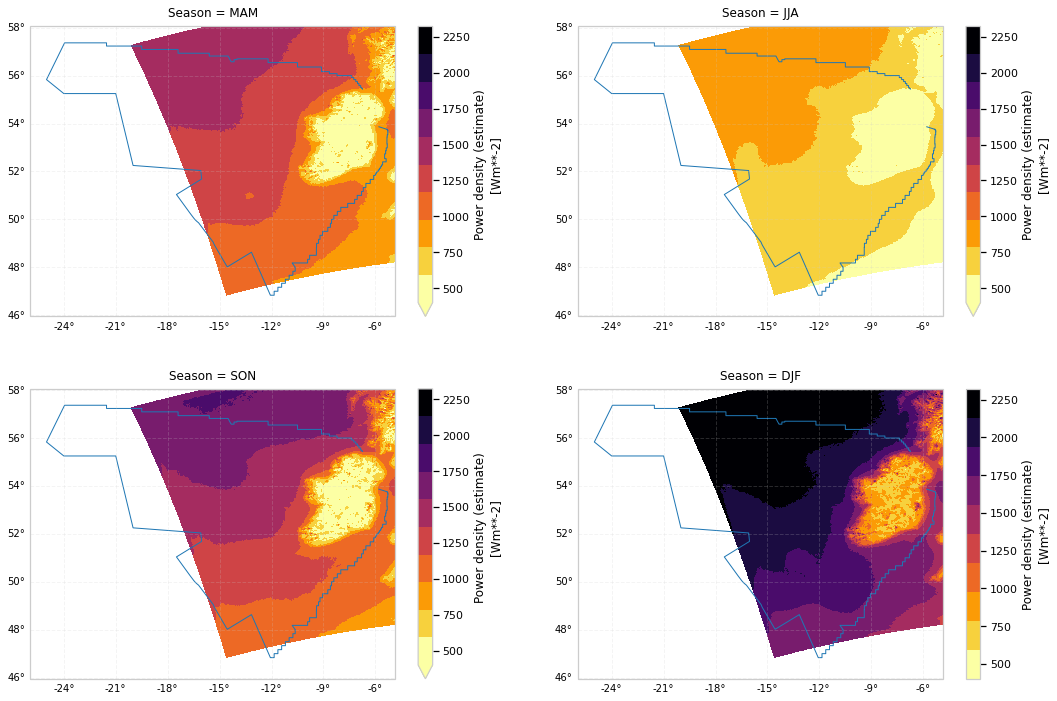
Operational and Maximum Yield Frequency¶
Maps of operational and maximum yield frequency, as discussed by Remmers et al., (2019), may also be generated for all data sets. These reflect the frequency at which power is generated, along with the maximum power yield:
Operational: wind speed = [3, 25]
Maximum yield: wind speed = [10, 25]
def plot_frequency(name: str, height: int, min_wind_speed: float, max_wind_speed: float, vmin: float, vmax: float):
"""Generate Operational/Maximum Yield frequency plots"""
fig, ax = plt.subplots(nrows=2, ncols=3, figsize=(27, 12), subplot_kw=dict(projection=MAP_PROJECTION))
ax = ax.flatten()
for i, eooffshoreds in enumerate(PLOT_ICS_DATASETS):
wind_speed = eooffshoreds.dataset.wind_speed.sel(height=height)
# Determine the number of observations per cell
if eooffshoreds.incomplete_time_series:
num_observations = wind_speed.where(wind_speed.fillna(-1)!=-1).count(dim='time')
num_observations = num_observations.where(num_observations > 0, other=1).compute()
else:
num_observations = eooffshoreds.dataset.dims['time']
frequency = (100 * (wind_speed.where((wind_speed >= min_wind_speed) & (wind_speed <= max_wind_speed)).count(dim='time') / num_observations))
frequency.name = name
frequency.attrs['units'] = '%'
plot_ics_variable(variable=frequency.compute(),
title=f'{eooffshoreds.name} ({format_plot_time(eooffshoreds.dataset.time.min())} - {format_plot_time(eooffshoreds.dataset.time.max())})',
vmin=vmin,
vmax=vmax,
ax=ax[i],
cmap=plt.cm.get_cmap('viridis', 10)
)
fig.suptitle(f'{height}m {name} - Wind Speed $\in$ $[{min_wind_speed}, {max_wind_speed}]$');
plot_frequency(name='Operational Frequency',
height=100,
min_wind_speed=CUT_IN_WIND_SPEED,
max_wind_speed = CUT_OUT_WIND_SPEED,
vmin=90,
vmax=100)
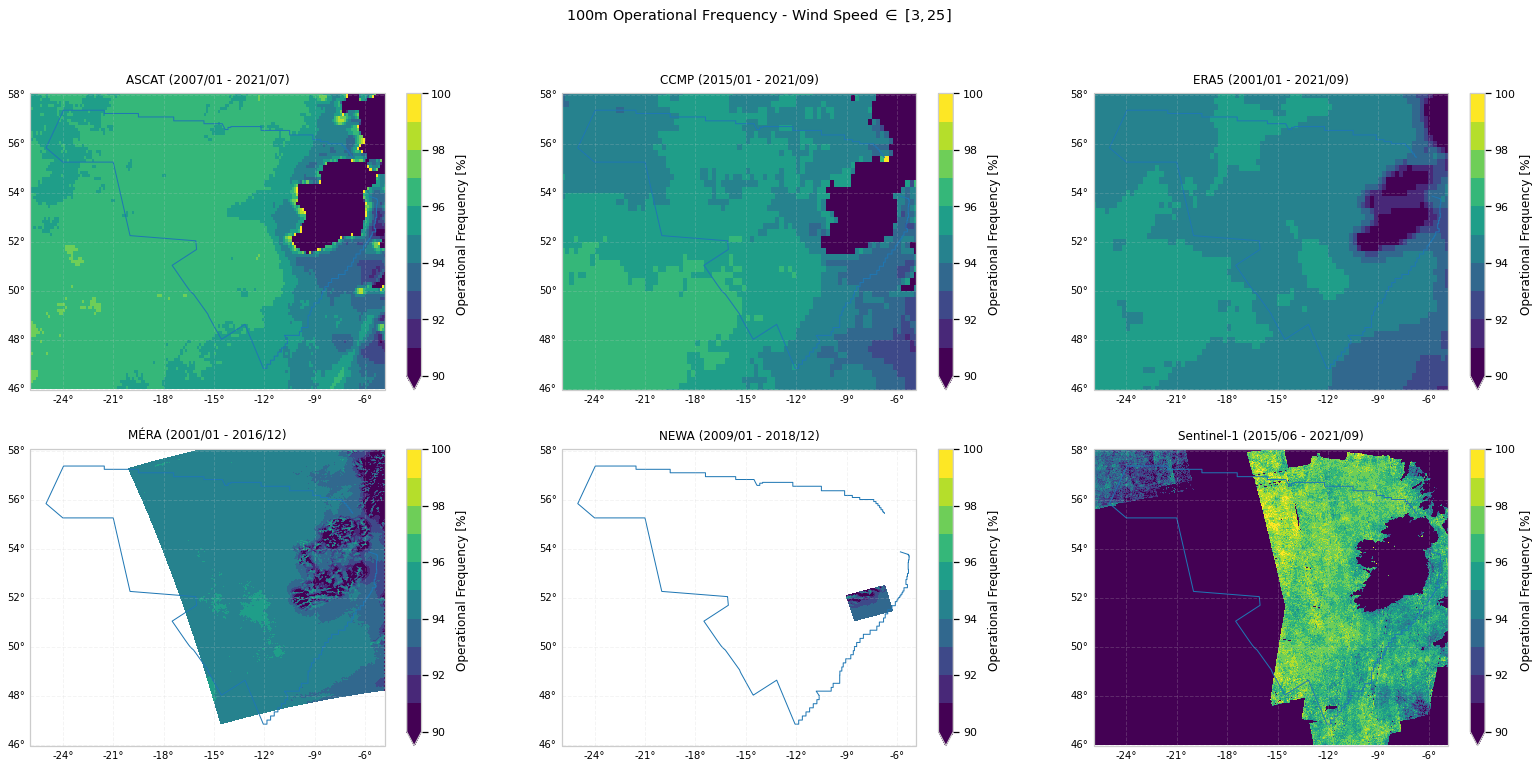
plot_frequency(name='Maximum Yield Frequency',
height=100,
min_wind_speed=10,
max_wind_speed = CUT_OUT_WIND_SPEED,
vmin=40,
vmax=70)
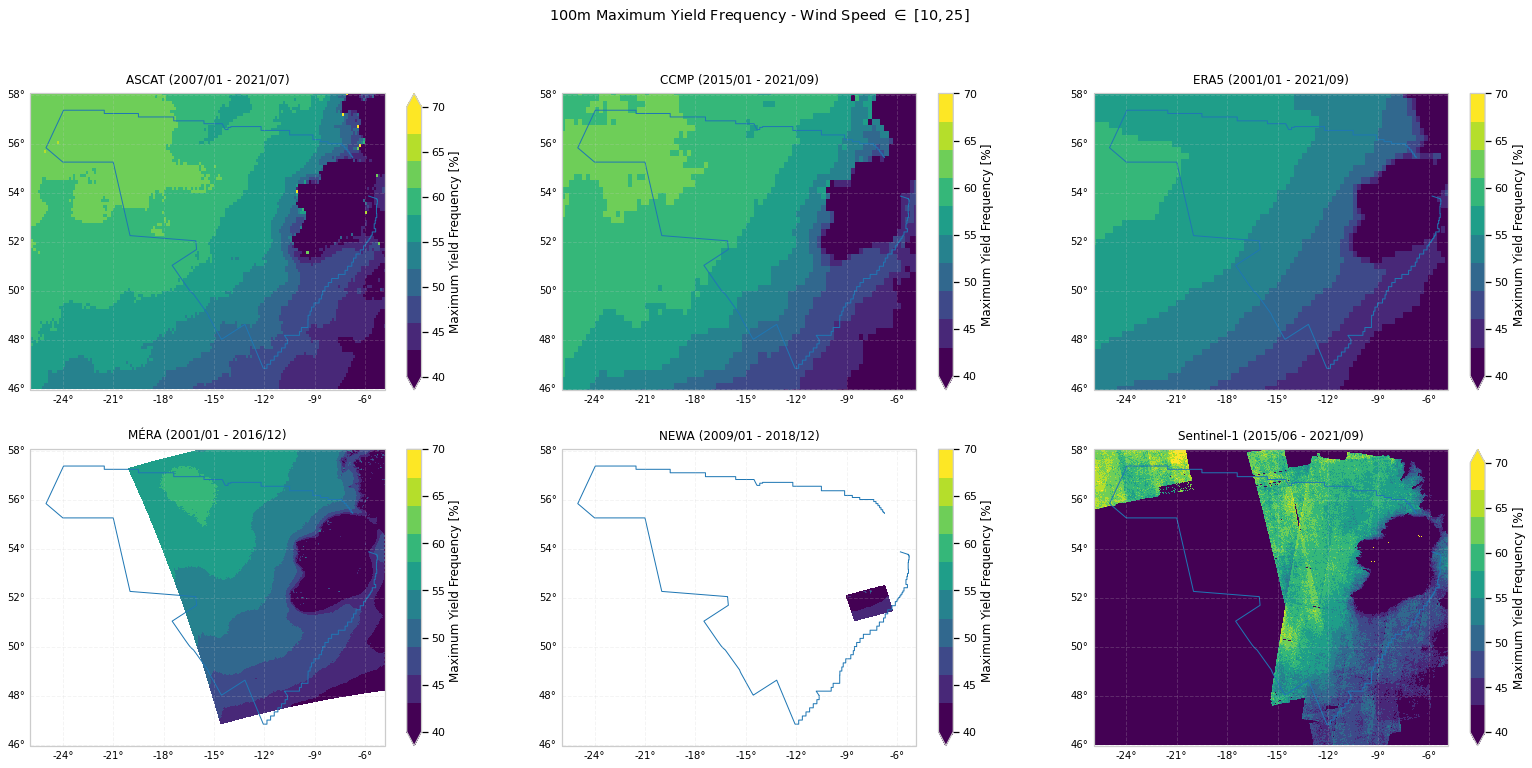
AOI power density summary¶
Mean 100m power density (\(Wm^{-2}\)) for all buoy and wind farm AOIs
nanvalues indicate no data was found for a particular AOI (see mean map plots above)
aoi_summary(datasets=DATASETS, variable='power_density', height=100).style.format('{:,.0f}')
| ASCAT | CCMP | ERA5 | MÉRA | NEWA | Sentinel-1 | |
|---|---|---|---|---|---|---|
| M2 | 977 | 1,114 | 958 | 997 | 1,010 | 1,175 |
| M3 | 1,195 | 1,185 | 1,159 | 1,164 | 1,166 | 1,265 |
| M4 | 1,342 | 1,342 | 1,282 | 1,325 | 1,336 | 1,546 |
| M5 | 1,055 | 1,054 | 1,029 | 1,050 | 1,016 | 1,176 |
| M6 | 1,518 | 1,453 | 1,433 | 1,376 | nan | nan |
| Irish Sea 1 | 1,132 | 843 | 676 | 797 | 805 | 851 |
| Irish Sea 2 | 937 | 908 | 694 | 843 | 840 | 815 |
| Irish Sea 3 | 932 | 1,003 | 833 | 892 | 894 | 892 |
| Celtic Sea 1 | 898 | 980 | 777 | 923 | 915 | 933 |
| Celtic Sea 2 | 917 | 993 | 823 | 954 | 934 | 956 |
Power density time series¶
Similar to wind speed time series above, using the power_density variable.
Sentinel-1 is excluded as it uses the Weibull method for power density estimation, and consequently has no
timedimension.
100m power density since 2001 for IWB buoys¶
Using the M2 buoy as an example IWB AOI
plot_buoy_aoi_summary(buoy='M2', datasets=[ascat, ccmp, era5, mera, newa], variable='power_density', height=100)

100m power density since 2001 for wind farms¶
Using the Celtic Sea 1 wind farm as an example AOI. Mean power density is calculated using corresponding wind farm grid coordinates spatial means.
plot_windfarm_aoi_summary(windfarm='Celtic Sea 1', datasets=[ascat, ccmp, era5, mera, newa], variable='power_density', height=100)
